p. 8
p. 9
p. 13
p. 14
p. 14
p. 15
p. 16
LAIA ESTRUCH 2011–2025
LATITUDES
JINGLE
SERENDIPITY
NO A LA GUERRA
65
PERFORMANCE AL TEATRE
DOCUMENT VIU, DOCUMENT MORT, DOCUMENT DINÀMIC, DOCUMENT
ESTÀTIC
p. 17
p. 18
p. 27
p. 39
p. 39
p. 46
p. 46
p. 55
p. 60
p. 60
p. 60
p. 62
p. 66
p. 66
p. 77
p. 78
p. 79
p. 84
p. 85
p. 85
p. 94
p. 102
p. 102
p. 103
p. 104
p. 104
p. 104
p. 153
p. 171
p. 181
/FU:D/
ÀLBUM VICTÒRIA
MOAT
TOLL GORGA ULL D’AIGUA
SIBINA
LIED
CROL
GANIVET
CANTAR L’AIGUA
CLOS/SOLC
MIX
SIRENA FARONDA
OCELLS PERDUTS
ZÓCALO
IMPROVISACIONES
RESIDUA
HUTE
CRUZADAS
KITE
TRENA
VOZES DE BALEIA
CRIT
LENGUAS DE AGUA ERA
HELLO EVERYONE AUDIO
HELLO EVERYONE VÍDEO
LAIA ESTRUCH: VOICE-BODY-SCULPTURE LATITUDES
OCCUPATIONS OF TIME AND SPACE
SHARON HAYES
A VOICE IS DIFFICULT TO REMEMBER
LAIA ESTRUCH IN CONVERSATION WITH MARC NAVARRO
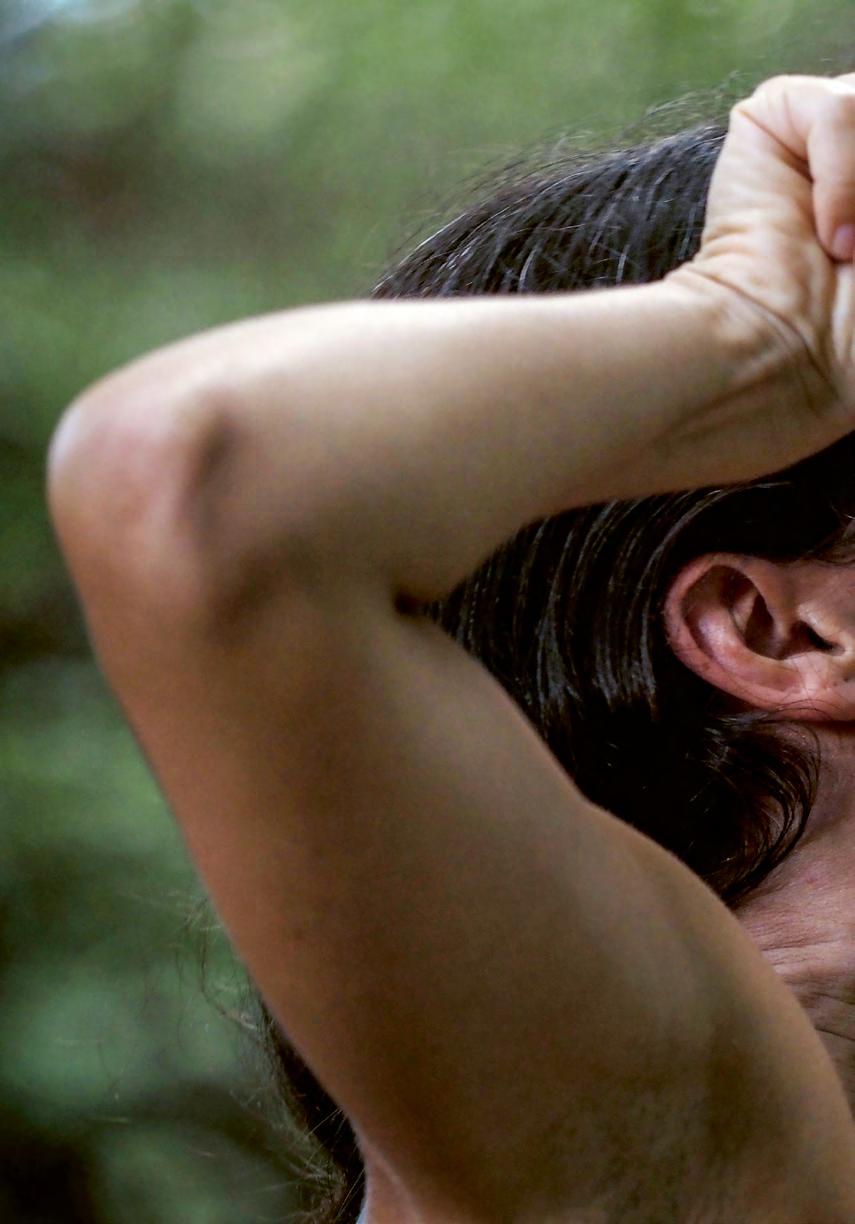

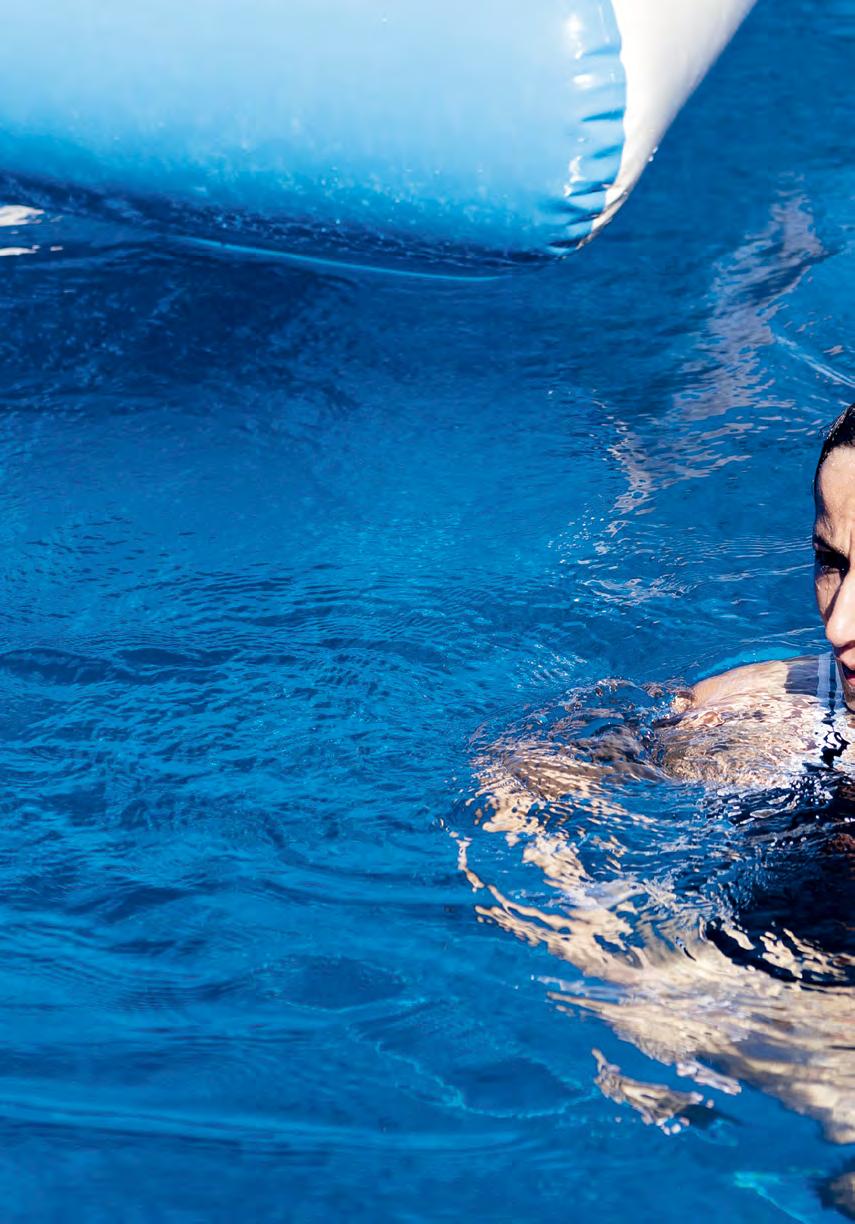

The following section functions as both an inventory and an abbreviated catalogue raisonné aligning with the concept of the exhibition Laia Estruch: Hello Everyone as a navigable warehouse—a dynamic repository where sculptural resources and vocal expressions are stored and classified. It encompasses Laia Estruch’s artworks, performances, iterative series (such as Kite , 2022–24), and projects (titles that bring together discrete works and performances, including Performance al teatre [Performance at the Theater], 2012).
Spanning the period from 2011 to February 2025, the text is organized chronologically based on what is considered a first presentation, with detailed entries provided for each. Following presentations—whether as part of exhibitions, festivals, or one-off events—and, in some cases, antecedent presentations (where early versions predate what is now identified as the first presentation) are addressed more concisely. These entries highlight elements retained from the original presentation and, where applicable, note the introduction of new components.
Detailed descriptions, a selection of photographs and textual scores, and the characteristic colors of Estruch’s work expand and contract this timeline, alongside a system of coded archival registrations, which function like product serial numbers. These registrations are derived from the title, location, color, and date of the artwork and its first presentation and/or performance characteristics. For example, the registration number for Ganivet (2020/2025)—GFBBTO20I35—is composed of: G (Ganivet ), FBB (Fundació Joan Brossa, Barcelona), TO (Traffic Orange), 20 (2020), I (Interior), and 35 (35 minutes). The symbols
and their variations indicate a work’s inclusion in the exhibition Laia Estruch: Hello Everyone at the Museo Reina Sofía in 2025. Originating in a system for annotating bodily movements developed in the 1680s, these symbols were designed to represent arm movements. Much like Estruch’s registrations that codify information about each work, these markings—poised midway between gesture and writing—evoke the artist’s use of her arms in her performances, in which she traces graphic figures such as crosses or cuts in the air, expanding the connection between movement, form, and meaning.
Jingle was self-consciously conceived as a catalyst for Laia Estruch’s entrance into the Barcelona art world. The project emerged from the premise that, instead of a traditional printed invitation card for a launch event, communicative form and informational content could be rerouted into the medium of sound, combining melody and voice, and the announcement itself could comprise a work of art. Enlisting the collaboration of music producer Xavi Lloses, Estruch developed different versions of an infectiously catchy electronic jingle to accompany an unfolding account of the project’s genesis and development.
Through a series of three debut shows, each introduced by a variation of the core jingle, Estruch performed alone at the microphone within a white-cube stage, bathed in pink neon light—a deliberately self-mythologizing scene. The project functioned as a self-promotional viral campaign, enhanced by the graphic design of Ariadna Serrahima and the input of other professionals working in the voice acting and scenographic fields. It culminated in the launch of a 7-inch vinyl record in which Estruch’s voice was released as a force of artistic meta-marketing and packaged as a pop cultural artifact. Jingle’s speak-singing cadence had an irresistible “earworm” effect, leaving its opening lines, “Hello everyone my name is Laia Estruch...” lingering in audiences’ minds days or even years later.
Performance: solo, amplified, 3 parts, approx. 20 min. each
Audio: Jingle, 7″-vinyl edition, 5 parts, “The Announcement” (1:54 min.), “Jingle” (0:29 min.), “Track 1” (1:18 min.), “Track 2” (1:06 min.), “Track 3” (2:08 min.); sound installation, duration variable
Video: 11:26 min.
Graphic work: poster, 2012, approx. 60 × 42 cm
First presentation: BCN Producció’11, Espai Cub, La Capella, Barcelona, April 14–May 29, 2011 (sound installation; performances: April 14 / April 28 / May 12 / May 26, 2011)
Produced by: La Capella
Tutor: Joan Morey
Audio production: Xavi Lloses
Video production: Mireia Sallarès, Eva Vilamala
Graphic design: Ariadna Serrahima
Costume design: El Delgado Buil
Following presentations:
Hello Everyone, Demolden Video Project, Santander, April 27–May 31, 2012 (video; performance: April 27, 2012)
Blind Dates in Rita McBride’s “Arena,” Museu d’Art Contemporani de Barcelona (MACBA), June 20–September 20, 2012 (poster; performance: July 18, 2012)
Recreational Duty, Junefirst Gallery, Berlin, April 25–May 16, 2014 (performance: April 25, 2014)
Les escenes. 25 anys després, La Capella, Barcelona, January 27–June 23, 2019 (sound installation: January 27–February 10 / April 9–May 5, 2019; performance: April 25, 2019)

SHOW 1
Hello everyone my name is Laia Estruch and I would like to announce the lecture on the history of my project
Based on the audio document of the performance «The Announcement»
Where I used a melody to convey the content of an invitation to an event
I have started a collaborative process with a musician
That will culminate in the creation of an audio identity document
This presentation is a sung explanation
Of a process of transformation
Where the song «The Announcement»
Will take on the form of a commercial jingle
The idea is to dramatize the dialogue with the music producer
To maximize the words and sounds
That are being generated throughout this process
This presentation is a sung explanation
Of a process of transformation
Where the song «The Announcement»
Will take on the form of a commercial jingle
The first step was to find the musical style
That most suited the melody And to harmonize it accordingly
Then we tried different instruments and decided that the best one was the mellotron
This presentation is a sung explanation
Of a process of transformation
Where the song «The Announcement»
Will take on the form of a commercial jingle
SHOW 2
Hello everyone my name is Laia Estruch and I would like to announce the lecture on the history of my project
We looked for a structure To convert the narrative of the process into musical lectures
At the same time we were moving on in the musical and conceptual elaboration of the jingle
Abstract noise, Locomía mix banjo riff and old country licks
It sticks (it sticks)
We looked at the jingle cell and selected the catchiest part of it
Hello everyone my name is Laia Estruch from the song «The Announcement» and then we found a banjo riff that suited it from an American folk compilation
Abstract noise, Locomía mix banjo riff and old country licks
It sticks (it sticks)
At the same time we were working on the graphic design of the vinyl record that will include the finished tracks from the musical process and the final form of the jingle
Abstract noise, Locomía mix banjo riff and old country licks
It sticks (it sticks)
SHOW 3
Hello everyone my name is Laia Estruch and I would like to announce the lecture on the history of my project Now we’ve elaborated the final product
An artistic statement in the form of a jingle a catchy tune like a piece of viral advertising that represents me as an artist I took some classes to articulate the text and project my voice to sing the history of the project giving it the form of a musical lecture
We looked for the best way to fit the text to the abstract bases created with the music producer I was to sing it, I had to recite it I came back to the idea of introducing the jingle a catchy tune like a piece of viral advertising that represents me as an artist Instead of using the music as the base of the performances I chose to use the structure of a song to deliver the narrative I decided to sing the content a cappella and then play the music tracks that record the process of transformation of the song «The Announcement» into the tune of a jingle a catchy tune like a piece of viral advertising that represents me as an artist Jingle a catchy tune like a piece of viral advertising that represents me as an artist
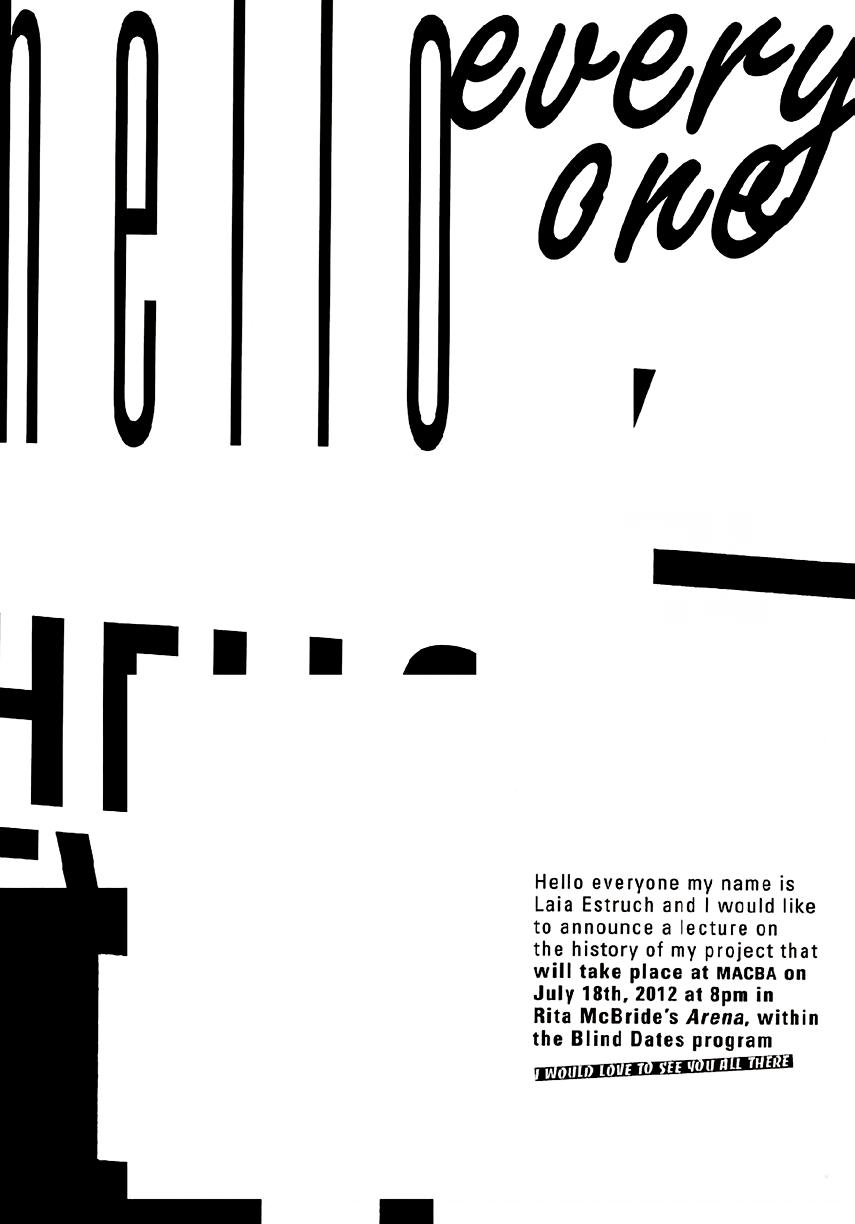

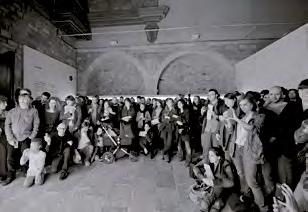



Performance: solo, amplified, 3 parts (“Chapter 1,” “Chapter 2,” “Chapter 3”), approx. 30 min. each
Publication: Ariadna Estalella, Anna Llarch, and Marta Vilà, eds., Serendipity. Un conte meravellós, Barcelona: Sala d’Art Jove de la Generalitat de Catalunya, 2011
First presentation: Assonàncies, Ressonàncies, Dissonàncies i Estridències, Projectes de Creació 2011, Sala d’Art Jove de la Generalitat de Catalunya, Barcelona, June 2–September 15, 2011 (publication; performances: June 2 / June 30 / July 21, 2011)
Produced by: Sala d’Art Jove de la Generalitat de Catalunya
Curated by: Ane Agirre, Juan Canela, Julieta Dentone, Alexandra Laudo
Graphic design: Ariadna Serrahima
Following presentation: Segueix els rastres com si fos miop – 10 anys de Sala d’Art Jove, Arts Santa Mònica, Barcelona, July 19–October 2, 2016 (performance: July 26, 2016)
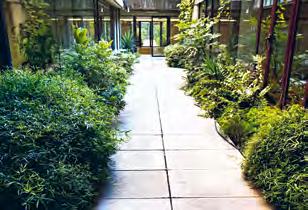
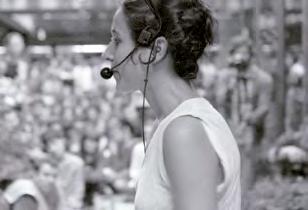


NO A LA GUERRA 2012
(No to War) This press clipping features an image captured by a photographer from the news agency Agencia EFE, published in the Barcelona edition of the newspaper La Razón on March 31, 2003. The photograph records a moment from a mass demonstration in Barcelona in which Estruch, then a Fine Arts student, participated. The event occurred in the context of the buildup to the invasion of Iraq by a United States-led coalition, which began later that month and was supported by the Spanish government. Years later, the artist realized how this document of a spontaneous moment of solidarity and protest recalled images from our collective memory of historic social justice movements from the 1960s and 1970s, as well as appearing to be an unwitting homage to the pioneering women of performance art from the same period.
Graphic work: No a la Guerra, press cutting in wood and acrylic frame, 19.5 × 30 × 4 cm
Presented at: Paraula i veu, Franco de Toledo Art Projects, Barcelona, May 24–July 20, 2012
Curated by: Laia Estruch, Joan Morey

65 2012
Performance: solo, unvoiced, 20 min.
Costume: leather playsuit
Presented at: Això no és una exposició, tampoc, Fabra i Coats: Centre d’Art Contemporani, Barcelona, September 28, 2012–January 27, 2013 (performance: November 15, 2012)
Produced by: Fabra i Coats: Centre d’Art Contemporani
Curated by: David G. Torres
Costume design: Jordi Espino


(Performance at the Theater)
Performance al teatre culminated in a forty-five-minute one-act vocal improvisation presented at La Villarroel theatre, Barcelona, on December 10, 2012 (Performance al teatre. En lloc d’actuar fabulo [Performance at the Theater: Instead of Acting I Fabulate], 2012). The performance derived from a four-hour videotaped conversation between Estruch and her father that she transcribed and transformed into a monologue composed entirely of nonverbal vocalizations and sound cues. A quasi-therapeutic exercise, the project is an attempt to distill his speech, intonation, and behavior— articulating the emotions and topics of a dialogue we can only partially grasp—into her own glossary of expressions. Through raspy exclamations and sibilant mumbling, gruff gasps and sputtering plosives, Estruch reframes a conversation precisely by not having the words to convey it.
Performance: Performance al teatre. En lloc d’actuar fabulo, solo, amplified, 45 min.; Entendre’m no m’entendràs perquè no m’entenc ni jo (Understand Me You Won’t Understand Me
Because I Don’t Even Understand Myself), Puc viure dues o tres vides paral·leles perfectament (I Can Live Two or Three Parallel Lives Perfectly Well), Segueixo sense tatuatges (I Still Have No Tattoos), 3 performance reading preludes, solo, amplified, each with corresponding graphic work, approx. 30 min. each
Audio: Performance al teatre, compact disc, 7″-vinyl format edition, 6 parts, performance recording (48:11 min.), 5 studio rehearsals (approx. 1 min. each)
Video: Performance al teatre, approx. 50 min.
Graphic work: Entendre’m no
m’entendràs perquè no m’entenc ni jo; Puc viure dues o tres vides paral·leles perfectament ; En lloc d’actuar fabulo; Segueixo sense tatuatges; 4 works, language, vinyl, dimensions variable; playbill, approx. 21 × 29.7 cm
Antecedent presentations:
Pas de Deux, The Private Space Gallery, Barcelona, February 2–17, 2012 (graphic work; performance Entendre’m no m’entendràs perquè no m’entenc ni jo: February 2, 2012)
Secció irregular, Graner, Barcelona (performance Puc viure dues o tres vides paral·leles perfectament : April 1, 2012)
Paraula i veu, Franco de Toledo Art Projects, Barcelona, May 24–July 20, 2012 (graphic work; performance Segueixo sense tatuatges: May 24, 2012)
First presentation: BCN Producció’12, La Villarroel, Barcelona (playbill; performance Performance al teatre. En lloc d’actuar fabulo: December 10, 2012)
Produced by: La Capella
Tutor: Joan Morey
Audio production: Carlos Gómez
Video production: Biel Mauri
Graphic design: Ariadna Serrahima
Following presentation: Demolden Video Project, Arte Santander, Santander, July 20–August 3, 2013 (playbill, audio, and video Performance al teatre)

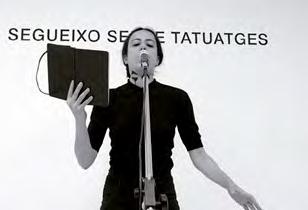


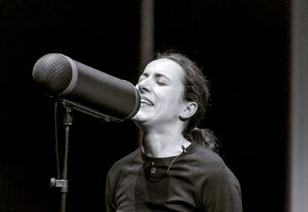



DOCUMENT VIU, DOCUMENT MORT, DOCUMENT DINÀMIC, DOCUMENT ESTÀTIC (Living Document, Dead Document, Dynamic Document, Static Document) Performance: solo, unamplified, unvoiced, approx. 30 min.
Video: 1:42 min.
Presented at: Experimentem amb l’ART, Barcelona, May 14, 2013
Produced by: Laia Estruch
Video production: Victor Mata


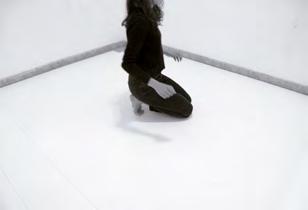
/FU:D/ 2014–16
/fu:d/ (“food” in the phonetic alphabet) comprises a series of vocal works— including live performances and cassette tape tracks—and a nonsequential libretto of nearly 200 sheets of seemingly hastily brushed words. The English fragments on these pages derive from Mrs. Beeton’s Book of Household Management (1861), an influential cookbook and domestic manual for middle-class Victorian British women. The Spanish phrases are based on wordof-mouth recipes and onomatopoeic phrases that Estruch gathered in Andalusia. Playfully engaging with etiquette, pronunciation, and the notion of recipes as written protocols, Estruch reads these sheets like a maverick, experimental town crier, delivering announcements and lively vocal interpretations of her own documents of inherited culinary knowledge.
Performance: solo, amplified, with graphic works, approx. 45 min.
Audio: /fu:d/ A Selection of Vocal Essays 2014–15, 2016, cassette tape edition, 2 parts, “A” (39:09 min.), “B” (45:26 min.); vocal essays, duration variable;
sound installation, approx. 300 min. loop; /fu:d/ El Cachanilla, 2015, 55:08 min.
Video: /fu:d/ Reading Studies, approx. 15 min.
Graphic works: /fu:d/, ink on paper, up to 198 parts, 59.5 × 42 cm each; Bizcocho Cuadrado Herradura Suspiro (Sponge Cake Square Horseshoe Sigh), vinyl, dimensions variable
First presentation: CoMbO #4. Breakfast in Bed, CoMbO, Córdoba, Spain, June 6–July 4, 2014 (vocal essays; video; /fu:d/ Reading Studies; graphic works /fu:d/ and Bizcocho Cuadrado Herradura Suspiro; performance: June 6, 2014)
Produced by: Laia Estruch, Asociación La Fragua, CoMbO
Curated by: Jesús Alcaide, Anders Grønlien, Gaby Mangeri, Javi Orcaray
Audio production: Pablo Miranda
Video production: Laia Estruch
Following presentations:
Sala Gratx, Barcelona (performance: July 23, 2014)
Intervalo. Acciones sonoras, Fundació Antoni Tàpies, Barcelona, November 7, 2014–February 15, 2015 (sound installation; performance: December 10, 2014)
A Selfless Self in The Nightless Night; Disembodied Voices & Imaginary Friends, Bar Project at Espacio Práctico, Barcelona (performance: November 25, 2014)
Primer Cicle de Poesia Fonètica i Sonora, 44Perills Art Sonor, Barcelona (performance: November 26, 2014)
SIS Galeria, Sabadell, April 10–May 30, 2015 (sound installation; video; graphic work /fu:d/; performance: April 10, 2015)
Disfonías, Centro Párraga, Murcia, April 29–June 17, 2016 (graphic work /fu:d/; performance: April 29, 2016)
El imitador de voces, Teatro Pradillo, Madrid, November 18–26, 2016 (performance: November 19, 2016)
Prix Bob Calle du livre d’artiste 2017, Chapelle des Petits-Augustins des Beaux-Arts de Paris, October 16, 2017 (/fu:d/ A Selection of Vocal Essays 2014–15 )
Trapos sucios, El Cachanilla Restaurante, Mexico City, February 8–10, 2018 (audio /fu:d/ El Cachanilla; graphic work /fu:d/ )
La Fragua. Artist Residency. Belalcázar, Córdoba 2010–2016, Centro de Arte Rafael Botí, Córdoba, Spain, November 3, 2023–January 14, 2024 (graphic work /fu:d/ )





ÀLBUM VICTÒRIA
2015–20 (Victoria Album) Àlbum Victòria began with the discovery, in a Barcelona flea market, of an album of small, Surrealist-influenced works on paper by the painter Jordi Samsó (Barcelona, 1929–2008). This serendipitous find became the catalyst for a series of solo performances in which Estruch interprets Samsó’s drawings by translating their graphic language into spoken-word pieces and song lyrics. For instance, “Una cara de cabra, un cos de cargol ... Avui cremo avui bullo avui aixeco pols” (A face of a goat, a body of a snail ... Today I am burning today I am boiling today I’m kicking up dust). These lyrics have also been brought to life in a series of energetic concert performances, with Estruch as a guest vocalist “shouting the drawings” alongside different bands known for their raw and intense sound. Notable collaborations include a gig in Mexico City with the band Joliette in 2020 and another with the Galician group Samesugas in Santiago de Compostela the following year.
Performance: solo, amplified, with poster scores, approx. 60 min.; collaborative, amplified, with poster scores, duration variable
Audio: collaborative performance at La Isla, performance recording, 2018 (51:53 min.); collaborative performance with Joliette, performance recording, 2020 (47:37 min.)
Videos: collaborative performance at La Isla, 2018 (51:44 min.)
Graphic work: Jordi Samsó, Untitled, undated, folio of drawings, pencil and ink on paper, dimensions variable; Àlbum Victòria Partitura (Victoria Album Score), 2015, poster score, 59.4 × 84.1 cm; Castell Tetris (Tetris Castle), playbill, 2016, 21 × 29.7 cm; Àlbum Victòria Partitura Mèxic (Victoria Album Score Mexico), 2020, poster score, 59.4 × 84.1 cm
Antecedent presentation: Poesia i +, Fundació Palau, Caldes d’Estrac, July 3–11, 2015 (performance: July 3, 2015)
First presentation: No Song to Sing, ADN Platform, Sant Cugat del Vallès, November 21, 2015–April 1, 2016 (performance: November 21, 2015)
Produced by: ADN Platform
Curated by: David Armengol, Martí Manen
Following presentation:
Tercero A, Barcelona (graphic work Castell Tetris; performance: March 12, 2016)
La Isla, Barcelona (collaborative performance with Xavi Lloses, Nico Roig, and Oriol Roca: April 18, 2016)
Barcelona Poesia, Fundació Joan Miró, Barcelona (performance: May 5, 2016)
Veure la veu, Festival Perifèric, Ermita de Sant Baldiri, Cadaqués (performance: July 1, 2016)
Reunió 1, santcorneliarts(2), Capella de Sant Corneli, Cardedeu, July 6–August 19, 2018 (performance: July 6, 2018)
La cuestión es ir tirando, Centro Cultural de España en México, Mexico
City, February 7–May 24, 2020 (collaborative performance with Joliette: February 7, 2020)
Plataforma. Festival de Artes Performativas 2021, Parque de San Domingos de Bonaval, Santiago de Compostela, May 26–June 5, 2021 (collaborative performance with Samesugas: June 4, 2021)


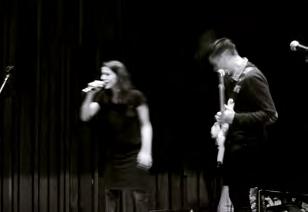
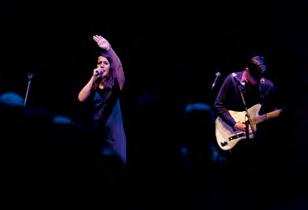

[ORIGINAL]
Peses molt per volar, per això voles arran de terra, peses molt per volar, per això voles arran de terra, t’he enlairat tan amunt com he pogut, ara no caiguis i m’aixafis, eh. Ets com un peix, ets com una nau, ets com un escuradents gegant, fas dos com jo, fas dos com jo. Peses molt per volar, per això voles arran de terra.
La roba també mor, la roba també mor li diu una dona a l’altra, la roba també mor, li diu una dona a l’altra, aixeca els braços endavant paral·lels a terra i deixa caure les mans mortes cap a baix. La roba també mor, la roba també mor. L’altra dona para la mà. Ja ho sé, dona’m el que em deus. Ni parlar-ne, la dona dels braços aixecats paral·lels a terra, marxa corrents flexionant les cames i l’esquena, les mans li pengen mortes cap a baix, i les va sacsejant al córrer, les va sacsejant al córrer.
Jo tinc el cap d’ocell, tu tens l’ull d’ocell. Jo tinc el cap d’ocell, tu tens l’ull d’ocell. Jo tinc el cap d’ocell, tu tens l’ull d’ocell.
El camí de la casa del bosc passa pel mig d’una taca negra, li surt una mà i dues finestres. El camí de la casa del bosc li està prenent tot a la casa del bosc.
Duc la meva signatura sobre meu, duc la meva signatura sobre meu. Un cuc em mira directament als ulls. Les plantes són més altes que jo. Duc la meva signatura sobre meu, duc la meva signatura sobre meu.
El meu cap és un laberint, el meu cap és una península. El meu cap és un laberint, el meu cap és una península.
La donzella del palau la seva cara és un plat. Entre les cortines de vellut i les escales de pedra, allarga el coll, allarga el coll.
He hagut de parlar amb el semàfor cara a cara, ell ha fet servir les mans per aturar-me.
Dues cares, dues carotes, dues cares, dues carotes, dues cares, dues carotes, dues cares, dues carotes.
Llenguts, llenguts, sóc la reina del mambo. Llenguts, llenguts, sóc la reina del mambo. Llenguts, llenguts, sóc la reina del mambo.
Sóc el dimoni català, sota la panxa duc escrit, dimoni català. Sóc el dimoni català, sota la panxa duc escrit, dimoni català. Sóc el dimoni català, sota la panxa duc escrit, dimoni català. Algú fa punteria, porto la senyera clavada al cap, algú fa punteria, porto la senyera clavada al cap. Sóc el dimoni català, sota la panxa duc escrit, dimoni català.
Vista aèria, vista aèria, tres trossos de terra, un animal amb dues potes.
Vista aèria, vista aèria una altra cara, vista aèria, vista aèria, l’animal està desproporcionat.
Torno a tenir bec, torno a tenir cap d’ocell, torno a tenir bec, torno a tenir cap d’ocell, torno a tenir bec, torno a tenir cap d’ocell, torno a tenir bec, torno a tenir cap d’ocell, torno a tenir bec, torno a tenir cap d’ocell.
Un ninot mous un ninot, un ninot mous un ninot mous un ninot, un ninot mous un ninot, un ninot mous un ninot.
Modegó ulls oberts escampats per tot arreu modegó ulls oberts escampats per tot arreu una
espasa algú fa el pont amb el seu cos modegó un racó i un home petit pensa modegó modegó modegó modegó.
El lleó i el nadó, el lleó i el nadó, el lleó i el nadó, el lleó i el nadó, el lleó i el nadó, el lleó i el nadó, el lleó i el nadó, el lleó i el nadó, el lleó i el nadó.
És un braç amb males herbes és un braç amb males herbes.
Dues dones despullades pel carrer. Una dona persegueix a l’altra, aixecant els braços i un puny. Una línia recta d’arbres al fons, una antena de cotxe travessa el camí d’arbres. Una cara mig d’home mig d’ocell, vola entre les dues dones despullades pel carrer, com una nau, com una nau.
Hi ha una finestra i dos punys, un puny és de la finestra, l’altre puny és de la cara tova que es desfà, una cara xata, una cara tova que es desfà. A la finestra hi ha una altra cara, és una carota. Hi ha un pal que aguanta la carota i un puny aguanta la cara que es desfà.
Ja no hi queda res a la ciutat, ja no hi queda res, ja no hi queda res a la ciutat, ja no hi queda res, ja no hi queda res a la ciutat, ja no hi queda res.
Un canelobre amb dos ulls oberts la cera li ha regalimat fins al peu, hi ha un gerro que balla amb flors i una fulla, també hi ha una gallina, com si fós una guardiola de fang al revés.
Un espanta-sogres en forma de cuc. Un espanta-sogres en forma de cuc. Un espanta-sogres en forma de cuc.
El sol em porta al cel, el sol em porta al cel, el sol em porta al cel.
He deixat enrere la nit, m’acomiado, dic adéu a la nit, deixo enrere la nit, m’acomiado li
giro l’esquena a la nit, li dic adéu a la nit, m’acomiado, prefereixo estar sola. Un fanal il·lumina el caos de la nit, deixo enrere el caos de la nit.
Un home baixa unes escales mecàniques molt petites. Li dic adéu a la nit, m'acomiado, li dic adéu a la nit.
Pistes d’esquí, fletxes que baixen, pistes d’esquí, fletxes que baixen. Jo passo, m’estiro al cim de la muntanya. Pistes d’esquí, fletxes que baixen.
Un mural espigues d’or, un cos. Un mural espigues d’or, un cos. Un mural espigues d’or, un cos. Un mural espigues d’or.
He anat a la muntanya, hola a totis, ja he arribat amb el meu barret petit. Que bé s’hi està a la muntanya. Els meus ulls s’obren de bat a bat, un cap de cuc volant com sempre. Jo t’abraço i de l’ull et surt un xiprer.
La plaça, la plaça, la plaça, la plaça, la plaça, una planta, un fanal, una planta, un fanal, la plaça, la plaça, la plaça, la plaça, una planta, un fanal, una planta, un fanal, una planta, la plaça, la plaça, la plaça, la plaça, la plaça, la plaça, la plaça, la plaça. Un carrer travessa la plaça, la plaça, la plaça, un carrer travessa la plaça, la plaça, la plaça, la plaça. Tinc els peus creuats a la plaça, la plaça, la plaça, una planta, un fanal, la plaça. Un carrer travessa la plaça, la plaça, la plaça, tinc els peus a la plaça, tinc les cames creuades a la plaça, la plaça, la plaça, la plaça. Un fanal, una planta, la plaça, la plaça, la plaça, la plaça, la plaça, la plaça, la plaça, la plaça. Caçapapallones, caçapapallones, dues nenes i un fil, gronxa’t del fil, gronxa’t del fil,
caçapapallones, caçapapallones, dues nenes i un fil, gronxa’t del fil. Anem a fer volar l’estel. Caçapapallones, caçapapallones, dues nenes i un fil, gronxa’t del fil, gronxa’t del fil.
Una caixa d’eines, una presó, una caixa d’eines, una presó. Una casa petita, barrots, barrots, barrots. Dos pins allargats, ombres, ombres, ombres. Una caixa d’eines una presó, una caixa d’eines, una presó. Una casa petita, barrots, barrots, barrots. Dos pins allargats, ombres, ombres, ombres.
Un plànol i al mig el meu cap, un plànol i al mig el meu cap, un plànol i al mig el meu cap, un plànol i al mig el meu cap.
Un tros de forca molt petita ha perdut el pal. Un plànol i al mig el meu cap, Un plànol i al mig el meu cap.
Ara T pot rata pot rata pot. Ara T pot rata pot rata pot. Ara T pot rata pot rata pot, un àngel estén les ales, el segueix un home a quatre grapes, un àngel estén les ales, el segueix un home a quatre grapes. Ara
T pot, rata pot, rata pot. Ara T pot rata pot, rata pot. Una cara de cabra, un cos de cargol, una cara de cabra, un cos de cargol. Potes de cabra pel cos de cargol, cara de cabra, cos de cargol, potes de cabra pel cos de cargol. Ara T pot, rata pot, ara pot, rata pot, rata pot
Castell tetris, cames tetris, porró tetris, carrer tetris, paper tetris, caixes tetris, castell tetris, cames tetris, porró tetris, carrer tetris, paper tetris, caixes tetris. Una mà entra dins del dibuix amb un gelat, amb un sis i un quatre aquí tens qui et retrata, Una mà entra dins del dibuix
amb un gelat, amb un sis i un quatre, aquí tens qui et retrata.
Sóc al terrat on tens el cap? et veig el cos. Sóc al terrat on tens el cap? et veig el cos.
Sóc al terrat on tens el cap? et veig el cos. Sóc al terrat on tens el cap? et veig el cos.
Tinc el cap quadrat, el pit quadrat, el cos quadrat, els peus quadrats, tinc el cap quadrat, el pit quadrat, el cos quadrat, els peus quadrats.
Sóc un cavall ajagut que ensenya les dents i mira cap amunt. Sóc un cavall ajagut que ensenya les dents i mira cap amunt. Sóc un cavall ajagut, que ensenya les dents i mira cap amunt.
Avui cremo avui bullo avui aixeco pols, avui cremo avui bullo avui aixeco pols, avui cremo avui bullo avui, aixeco pols, avui cremo avui bullo avui aixeco pols.
Cinquanta-tres més sis-cents igual a trenta-un mil vuitcents. Jo em penso que sóc i no sóc res, però sóc quan sóc i puc ser allò que sóc, que sempre em penso que no sóc.
You’re too heavy to fly, that’s why you fly close to the ground, you’re too heavy to fly, that’s why you fly close to the ground, I’ve sent you up into the air as high as I can, so don’t you fall and crush me, eh. You’re like a fish, you’re like a ship, you’re like a giant toothpick, you’re two of me, you’re two of me. You’re too heavy to fly, that’s why you fly close to the ground. Clothes die too, clothes die too says one woman to another, clothes die too, says one woman to another, she raises her arms in front of her, parallel to the ground, and lets her hands hang down dead. Clothes die too, clothes die too. The other woman holds out her hand. I know, give me what you owe me. Not a chance, the woman with the arms raised parallel to the ground runs off, flexing her legs and back, her hands hang down dead and she shakes them as she runs, she shakes them as she runs.
I have a bird’s head, you have a bird’s eye, I have a bird’s head, you have a bird’s eye, I have a bird’s head, you have a bird’s eye.
The path to the house in the forest cuts through a black stain, from which a hand and two windows emerge. The path to the house is taking everything from the house in the forest.
I carry my signature on me, I carry my signature on me, a worm looks at me straight in the eyes. The plants are taller than me. I carry my signature on me, I carry my signature on me. My head is a labyrinth, my head is a peninsula. My head is a labyrinth my head is a peninsula. The maiden of the palace has a plate for a face. Between the velvet curtains and the stone stairs, she stretches her neck, she stretches her neck.
I had to talk to the traffic lights face to face, he used his hands to stop me.
Two faces, two masks, two faces, two masks, two faces, two masks, two faces, two masks.
Big-tongues, big-tongues, I’m the queen of mambo. Big-tongues, big-tongues, I’m the queen of mambo. Big-tongues, big-tongues, I’m the queen of mambo.
I’m the Catalan devil, below my belly it is written, Catalan devil. I’m the Catalan devil, below my belly it is written, Catalan devil. I’m the Catalan devil, below my belly it is written, Catalan devil. Someone is taking aim, I’ve got the senyera stuck to my head, someone is taking aim, I’ve got the senyera stuck to my head. I’m the Catalan devil, below my belly it is written, Catalan devil.
Aerial view, aerial view, three pieces of land, an animal with two legs. Aerial view, aerial view, another face, aerial view, aerial view, the animal is out of proportion.
I have a beak again, I have a bird’s head again, I have a beak again, I have a bird’s head again, I have a beak again, I have a bird’s head again, I have a beak again, I have a bird’s head again, I have a beak again, I have a bird’s head again.
A doll you move a doll, you move a doll you move a doll, a doll you move a doll, a doll you move a doll.
Modegó open eyes scattered all around modegó open eyes scattered all around a sword someone makes a bridge with their body modegó a corner and a small man thinks modegó modegó modegó modegó.
The lion and the baby, the lion and the baby, the lion and the baby, the lion and the baby, the lion and the baby, the lion and the baby, the lion and the baby, the lion and the baby, the lion and the baby.
It’s an arm with weeds it’s an arm with weeds.
Two naked women on the street. One woman chases the other, raising her arms and a fist. A straight line of trees in the background, a car antenna crosses the path of trees. A face half-man half-bird flies between the two naked women on the street, like a ship, like a ship.
There’s a window and two fists, one fist belongs to the window, the other to the soft face that is dissolving, a flat face, a soft face that is dissolving. At the window there’s another face, it’s a mask. There’s a stick that holds up the mask and a fist that holds up the dissolving face.
There’s nothing left in the city, there’s nothing left there, there’s nothing left in the city, there’s nothing left there, there’s nothing left in the city, there’s nothing left there.
A candelabrum with two open eyes the wax has run down to its base, there’s a vase that dances with flowers and a leaf, there’s also a hen, like a clay piggy bank back to front.
A party blower shaped like a worm. A party blower shaped like a worm. A party blower shaped like a worm.
The sun takes me to the sky, the sun takes me to the sky, the sun takes me to the sky.
I’ve left the night behind, I bid farewell, I say goodbye to the night, I leave the night behind, I bid farewell I turn my back on the night, I say good-
bye to the night, I bid farewell, I prefer to be alone. A streetlight illuminates the chaos of the night, I leave the chaos of the night behind. A man goes down some very small escalators. I say goodbye to the night, I bid farewell, I say goodbye to the night.
Ski slopes, arrows that descend, ski slopes, arrows that descend. I pass, I stretch out on the mountaintop. Ski slopes, arrows that descend.
A mural golden wheat ears, a body. A mural golden wheat ears, a body. A mural golden wheat ears, a body. A mural golden wheat ears.
I’ve been to the mountains, hello everyone, I’ve arrived with my small hat. How good it is to be in the mountains. My eyes open wide, a worm’s head flying as always. I hug you and a cypress emerges from your eye.
The square, the square, the square, the square, the square, a plant, a streetlight, a plant, a streetlight, the square, the square, the square, the square, a plant, a streetlight, a plant, a streetlight, a plant, the square, the square, the square, the square, the square, the square, the square, the square. A street crosses the square, the square, the square, a street crosses the square, the square, the square, the square. I’ve got my feet crossed on the square, the square, the square, a plant, a streetlight, the square. A street crosses the square, the square, the square, I’ve got my feet on the square, I’ve got my legs crossed on the square, the square, the square, the square. A streetlight, a plant, the square, the square, the square, the square, the square, the square, the square, the square.
Butterfly net, butterfly net, two girls and a thread, swing from the thread, swing from the thread, butterfly net, butterfly net, two girls and a thread, swing from the thread. Let’s go and fly the kite. Butterfly net, butterfly net, two girls and a thread, swing from the thread, swing from the thread.
A toolbox, a prison, a toolbox, a prison. A small house, bars, bars, bars. Two elongated pines, shadows, shadows, shadows. A toolbox a prison, a toolbox, a prison. A small house, bars, bars, bars. Two elongated pines, shadows, shadows, shadows.
A plan and in the middle my head, a plan and in the middle my head, a plan and in the middle my head, a plan and in the middle my head. A piece of a very small pitchfork has lost its upright. A plan and in the middle my head, A plan and in the middle my head.
Now T can rat can rat can, Now T can rat can rat can, Now T can rat can rat can, an angel stretches its wings, it’s followed by a man on all fours, an angel stretches its wings, it’s followed by a man on all fours. Now T can, rat can, rat can. Now T can rat can, rat can. A goat’s face, a snail’s body, a goat’s face, a snail’s body. Goat’s legs for the snail body, goat’s face, snail’s body, goat’s face snail’s body. Now T can, rat can, now can, rat can, rat can.
Tetris castle, tetris legs, tetris porron, tetris street, tetris paper, tetris boxes, tetris castle, tetris legs, tetris porron, tetris street, tetris paper, tetris boxes.
A hand enters the drawing with an ice cream, with a six and a four here you have the person who portrays you, A hand enters the drawing with an ice cream, with a six and a four, here you have the person who portrays you.
Am I on the rooftop where is your head? I can see your body. Am I on the rooftop where is your head? I can see your body. Am I on the rooftop where is your head? I can see your body. Am I on the rooftop where is your head? I can see your body.
I have a square head, a square chest, a square body, square feet, I have a square head, a square chest, a square body, square feet.
I am a recumbent horse showing its teeth and looking upward. I am a recumbent horse showing its teeth and looking upward, I am a recumbent horse showing its teeth and looking upward.
Today I burn today I boil today I raise dust, today I burn today I boil today I raise dust, today I burn today I boil today I raise dust, today I burn today I boil today I raise dust. Fifty-three plus six hundred equals thirty-one thousand eight hundred. I think that I am and I am nothing, but I am when I am and I can be what I am, which I always think I am not.



Moat-1 marked the beginning of Estruch’s engagement with sculpture—conceived as what the artist refers to as a scene, stage, or scenario, and moreover a score, instrument, or archive—that allowed her to explore body movement and vocal expression while elevated above the floor, the traditional platform of both dance and theater. Comprising an industrially fabricated modular metal structure, Moat-1 is also the first of several projects related to playgrounds, particularly the elementary forms of play equipment like bars, arches, and domes, pioneered by urban planner Aldo van Eyck for vacant lots in post-World War II Amsterdam. A minimalist and geometric artwork— and simultaneously a climbing frame or agility training apparatus— Moat-1 is activated by the artist through the sculptural shapes and postures of her own body, which, in turn, influence the compression and expansion of her voice, leading to unexpected effects and sonorities.
As part of a residency project with Institut Juan Manuel Zafra in Barcelona, Estruch worked alongside a class of fourth-year secondary school students to develop Moat-2 / Playground Scene over the course of a school term. This collaborative endeavor resulted in two interconnected elements: a performance combining vocal expression with physical movement, and a sculpture featuring a raised bar adorned with three fluid S-forms. Moat-3 evolved Estruch’s notion of sculpture as a responsive and elevated stage-score through the use of air-filled forms typically seen in inflatable play structures, obstacle courses, or promotional displays. This development not only addressed practical concerns about the storage of large-scale sculptures but also
brought the artwork and the artist’s performance “show” closer to an ephemeral, portable, and reusable installation, reminiscent of a pop-up circus. With its pneumatic spheres and arches, Moat-3 adapts the rigid forms of the street playground into a soft, pliable body that even seems to breathe and hum. Estruch’s tactile and vocal interaction with it further draws out its anatomical qualities and buoyant attributes, as her presence on its surface causes its masses to yield and flex.
Moat-1 (2016)
Sculpture: painted steel, 180 × 250 × 350 cm overall (bench: 145 × 45 × 45 cm; large arch/bridge: 150 × 40 × 125 cm; small arch/bridge: 150 × 40 × 51 cm; ladder: 100 × 41 cm; 4 rings: 180 cm diameter each)
Performance: solo, amplified or unamplified, with sculpture, approx. 35 min.
Audio: Moat-1, soundtrack, 7 parts, “Episode 1” (4:07 min.), “Episode 2” (4:10 min.), “Episode 3” (3:49 min.), “Episode 4” (4:58 min.), “Episode 5” (4:31 min.), “Episode 6” (5:22 min.), “Episode 7” (4:32 min.)
Video: Assajos Hangar, novembre 2016 (Hangar Rehearsals, November 2016), 3 parts, 6:45, 5:25, 5:43 min.; Assajos Hangar, juny–juliol 2016 (Hangar Rehearsals, June–July 2016), 6 parts, 8:33, 12:57, 4:59, 2:13, 9:43, 6:30 min.; Moat (Antic Teatre), 41:35 min.
First presentation: Polivalents #9— Montacargas, Hangar | Centre de producció i recerca d’arts visuals, Barcelona (performance: July 29, 2016)
Produced by: Laia Estruch
Fabrication: Taller d’escenografia TeatreAuditori Sant Cugat
Audio production: Xavi Lloses
Following presentations: Antic Teatre, Barcelona (performance: December 1, 2016)
20th Festus, Festival d’arts al carrer,
Torelló, July 7–8, 2017 (performance: July 8, 2017)
A break can be what we are aiming for, BCN Producció’17, Sala Gran, La Capella, Barcelona, April 26–July 1, 2018 (performance: June 8, 2018)
Un món fràgil, Festival Embarrat, Museu Trepat, Tàrrega, May 25–June 1, 2021 (performance: May 28, 2021)
Col·lecció MACBA. Preludi. Intenció poètica, Museu d’Art Contemporani de Barcelona (MACBA), December 14, 2022–April 21, 2025 (sculpture: December 14, 2022–June 23, 2023)
Moat-2 / Playground Scene (2017)
Sculpture: painted steel, public artwork, 285 × 204 × 200 cm
Performance: collaborative, unamplified, with sculpture, approx. 40 min.; open public activation, with sculpture
First presentation: Institut Juan Manuel Zafra, Barcelona (collaborative performance with students: June 9, 2017)
Produced by: En Residència
Coordination: Associació A Bao A Qu
Fabrication: Taller d’escenografia TeatreAuditori Sant Cugat
With the participation of: Facundo Alvarez Tupine, Marc Cabezudo Cardona, Jose Antonio Castro Chapilliquen, Sara Franco de Torres, Sandra Gimeno, Adrián González Rodríguez, Elias Kammermeier Zambrano, Laura Prada Moreno, Verónica Moyano Vejarano, Isabella Cristina Palmieri Palomares, Clàudia Polanco Porras, Claudia Beatriz Rodríguez García, Elizabeth Rodríguez García, Pablo Rodríguez Peña, Oriana Orosa Benitez, Karla Salvador Sperandio, Miranda Sánchez Valiño, Helen Mishell Suárez Vásquez, Meritxell Valdelomar Yeng, Maria Vime Soriano, Marta Yeste Morant, Alex Valdivieso Miralles
Following presentations: Aquí hem trobat un espai per pensar, Fabra i Coats: Centre d’Art
Contemporani (collaborative
performance with students: April 11, 2019); Fabra i Coats: Fàbrica de Creació, Barcelona (public artwork and open public activation since April 11, 2019)
Moat-3 (2017)
Sculpture: polyester and PVC fabric, fan, ballast, approx. 400 × 300 × 200 cm
Performance: solo, unamplified, with sculpture, approx. 40 min.; Moat-3 Mix, solo, amplified, approx. 30 min.
Audio: Moat-3, soundtrack, streaming and digital download, 7 parts, “Episode 1” (3:44 min.), “Episode 2” (3:41 min.), “Episode 3” (4:02 min.), “Episode 4” (5:02 min.), “Episode 5” (2:36 min.), “Episode 6” (3:42 min.), “Episode 7” (3:27 min.)
First presentation: Acento 2018, La Casa Encendida, Madrid, January 24–26, 2018 (performance: January 24, 2018)
Produced and coordinated by: Artistas en Residencia 2017, La Casa Encendida / CA2M Centro de Arte Dos de Mayo
Fabrication: Tecnodimensión
Audio production: Xavi Lloses
Following presentations:
Constel·lació Cravan: Mina Loy, Olga Sacharoff, Otho Lloyd, Francis Picabia, Museu Picasso, Barcelona, January 11, 2018 (performance: Moat-3 Mix)
Back to School, Centro de Arte Rafael Botí, Córdoba, Spain, April 11–June 10, 2018 (sculpture; performance: April 11, 2018)
Frequency Singular Plural, CentroCentro, Madrid, April 26–November 29, 2019 (performance: May 24, 2019)
La nit del cos, Bombon Projects, Barcelona, June 8–July 25, 2019 (audio)
Low-Tech Music Session, La Virreina Centre de la Imatge, Barcelona, October 1–4, 2020 (performance: October 4, 2020)
Este puede ser el lugar. Performar el
museo, TEA Tenerife Espacio de las Artes, Santa Cruz de Tenerife, March 3–May 30, 2023 (sculpture; performances: April 15 / May 6, 2023) TNT Festival, Sala Muncunill, Terrassa, September 26–29, 2024 (sculpture; performance: September 27, 2024)






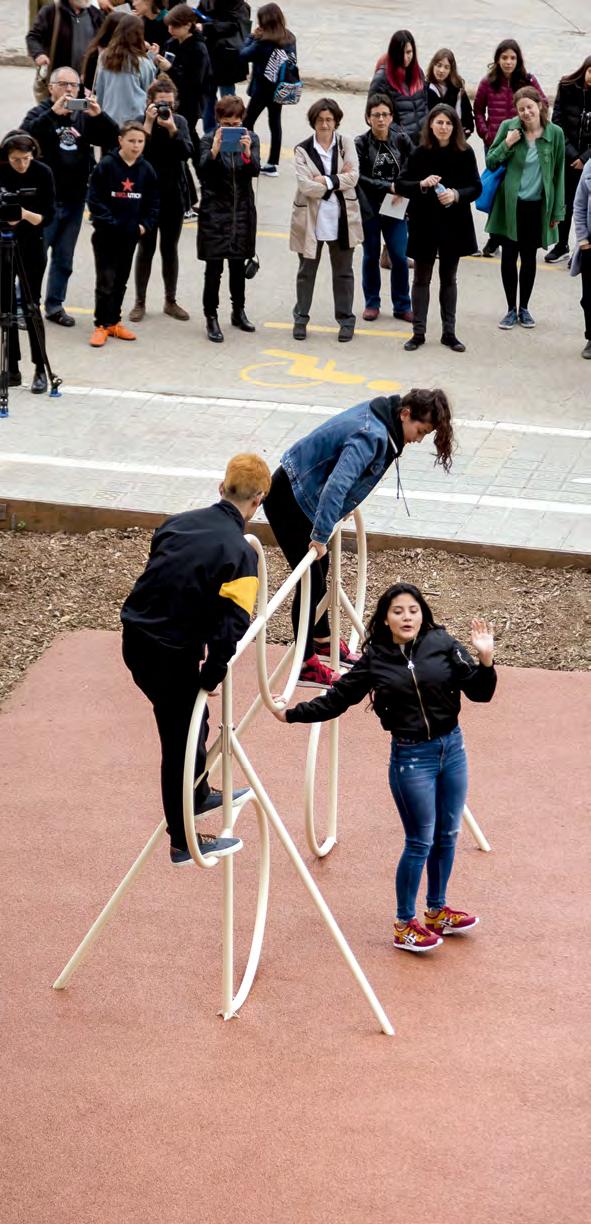


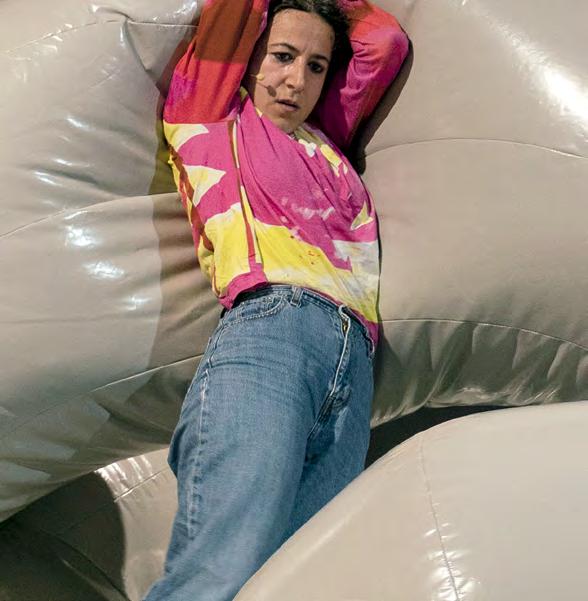



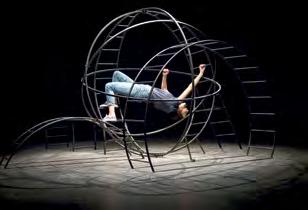


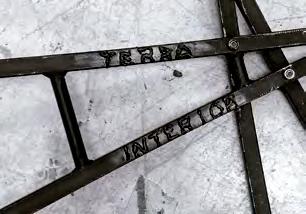




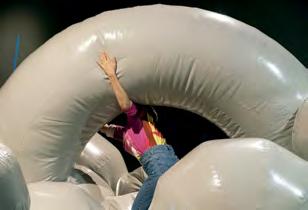

(Puddle Pool Spring) Sculpture: PVC
fabric, plastic containers, water, dimensions variable
Performance: solo, unamplified, with sculpture, approx. 20 min.
Graphic work: photogravure, letterpress, approx. 29 × 42 cm
Presented at: Acciones Sonhoras #12, Sonhoras, L’Automàtica, Barcelona, January 25, 2019
Produced by: Sonhoras
Fabrication: Laia Estruch, L’Automàtica

SIBINA 2019
Sibina is based around three sculptures that take the form of metal drinking troughs for livestock. It is one of Estruch’s first projects in her ongoing exploration of the capacities of the submerged voice and oral heritage tied to the medium of water. Rather than interpreting existing texts or documents as in earlier works, the accompanying performance—for which the vessels are filled with water—more freely incorporates selfscripted song lyrics and spoken chants, alongside splashes, gulps, and gurgles. Sibina makes particular reference to the hydrology and folklore of the Garraf, a coastal limestone massif near Barcelona with characteristic sinkholes and springs. Pagan legends born of such ecosystems in Catalonia tell of dones d’aigua (water-women), fairylike enchantresses who emerge from wells and cascades. Sibina evokes a mythology of hydration and ablutions, immersion and replenishment,
irrigation and tears: a confluence of landscape and body.
Sculpture: Sibina, painted steel, water, 3 parts, 2 parts: 140 × 30 × 85 cm each, 1 part: 140 × 30 × 110 cm
Performance: solo, unamplified, with sculpture, 35 min.
Audio: Sibina Cançó (Sibina Song), sound installation, 19:18 min. loop
Video: 18:05 min.
First presentation: “Una fuerza vulnerable” series, Capella de Sant Roc, Valls, May 19–July 28, 2019 (sculpture; performance: May 18, 2019)
Produced by: Capella de Sant Roc
Curated by: Juan Canela
Audio production: Xavi Lloses
Video production: Lluís Huedo
Fabrication: Taller d’escenografia TeatreAuditori Sant Cugat
Following presentations:
Swamp Horses, Spiritvessel, Espinavessa, June 15–August 15, 2019 (performance without sculpture: June 15, 2019)
On és la performance?, Centre d’Art Maristany, Sant Cugat del Vallès, November 30, 2019–March 7, 2020 (performance: March 7, 2020)
Poesia i +, Fundació Palau, Caldes d’Estrac, July 3–September 13, 2020 (sculpture; video)
Centre Enoturístic i Arqueològic de Vallmora, Teià (performance: July 3, 2020)
Social Lubricant & Water Politics, XX Art Flânerie, KunstBogen, Vienna, July 2–10, 2021 (video)
Océano Mar, Centro de Cultura
Contemporánea Condeduque, Madrid, April 26–July 23, 2023 (sculpture; performance: April 25, 2023)
Topalekuak , Tabakalera, Donostia-San Sebastián, June 21–October 6, 2024 (sculpture; performance: June 20, 2024)
Mare, que els ulls se’ns han fet d’aigua et vols beure el que veus et vols beure la veu
La noia del càntir mentre travessa els camps puja l’aigua amb les pedres i el caldo de l’ocell
Algú va disparar a l’ocell i el pou és negre llum dins l’aigua fa menys por de dia Igual dins dels forats d’aigua caus fort avall
Fredes i verdes pastora vés al riu s’hi t’hi mires a l’aigua fent lliscar el cos per les pedres
Ella va sortir perquè la necessitaven seràs sempre amb ella a l’aigua arrossegava els peus per les pedres la sang corria depressa
Vindré a l’aigua vindré on siguis
Que som com dos gorgs et vols beure la veu el porta lligat al cap
L’aigua està enverinada i l’aigua l’ha agafat si no ho haguéssim vist i ens guia senyals del bosc doll toll gorg
Ull d’aigua on puc nedar poc
Si et llances des de les roques fosques i grogues
pastora ferida el remei de la nit
En sentiràs un crit que serà eixit ella va sortir del niu humit de l’aigua del riu
Cobertes d’aigua freda fins els turmells. vindré a l’aigua
Tapa el forat amb una pedra l’aigua fuig
Tapa el forat amb el dit l’aigua fuig
Tapa el forat amb l’herba l’aigua fuig
Al matí vessen l’aigua et vols beure el que veus i balla el so de l’aigua
L’ull d’aigua s’ha tornat negre la galleda és vermella ja seríem mortes per terra
Llum dins l’aigua quan una entra al camí i el reflex en la nit és per a totes
puc enfonsar-me són les gorgues que a la gorga s’hi amaga que et dirà quin mal
Ella va sortir no els diguis qui és o seràs sempre amb ella a l’aigua
El pont queda a l’altra banda la sang es congelava
Vindré a l’aigua vindré on siguis
Tapa el forat amb el dit l’aigua fuig
Tapa el forat amb l’herba l’aigua fuig
Tapa el forat amb una pedra l’aigua fuig
Enfonsa la cara a l’aigua t’ajudes del front per beure si passeges sola de nit ni un mirall el bosc ho amaga tot
Dones que ajuden a la gent del camp paitides
S’agafa a la pedra i fan soroll d’ossos són circuits de vida a un costat la llacuna sents dos crits i un plor
Salts d’aigua quins són els cossos de l’aigua no els diguis qui sóc entre les roques plana i a poc a poc.
T’ajudes del cos per beure la teva ànima fa sonar l’aigua són les goges dansen entre crits aloges
El foc del front s’agafa a la roca neda a les profunditats és la cançó de l’aigua
L’aigua va quedar plana ulls d’aigua o et poden convertir en una pedra.
Les aigües no es poden fixar si els hi dius qui sóc dins les roques boques plenes d’aigua
Mother, our eyes have turned to water you want to drink what you see you want to drink the voice
The girl on the pitcher as she crosses the fields raises the water with stones and bird broth
Someone shot the bird and the well is black light in the water it’s less frightening in the daytime
Just as in the water holes you fall heavily
Cold and green shepherdess go to the river if you look into the water sliding the body across the stones
She went out because they needed her you will always be with her in the water she dragged her feet across the stones the blood flowed swiftly
I’ll come to the water I’ll come wherever you are
We are like two pools you want to drink the voice it’s tied to the head
The water is poisoned and the water has taken her if we hadn’t seen it and it guides us signs of the forest stream puddle pool
Eye of water where I can barely swim
If you throw yourself off the rocks dark and yellow
wounded shepherdess the remedy of the night
You’ll hear a cry that will be sharp she left the damp nest of the water of the river
Covered with cold water to the ankles.
I will come to the water
Plug the hole with a stone the water runs away
Plug the hole with a finger the water runs away
Plug the hole with grass the water runs away
In the morning they pour the water you want to drink what you see and dance the sound of the water
The eye of water has turned black the bucket is red we would already be dead on the ground
Light in the water when you start out on the path and the reflection in the night is for everyone I can plunge in it’s the pools in the pool one is hidden that will tell you what’s bad
She went out don’t tell them who it is or you will always be with her in the water
The bridge is on the other side the blood was freezing
I will come to the water I will come wherever you are
Plug the hole with a finger the water runs away
Plug the hole with grass the water runs away
Plug the hole with a stone the water runs away
Plunge your face into the water use your forehead to help you drink if you walk alone at night not even a mirror the forest hides everything
Women who help country folk nymphs
She clings to the stone and they make the noise of bones they are cycles of life to one side the lagoon you hear two screams and a sob
Waterfalls which are the bodies of water don’t tell them who I am amid the rocks smooth and gradually.
You use your body to help you drink your soul makes the water sound It’s the goges dancing while shouting aloges
The fire of the forehead clings to the rock it swims in the depths it is the song of the water
The water was left smooth eyes of water or they can turn you into a stone.
The waters cannot be stilled if you tell them who I am in the rocks mouths full of water
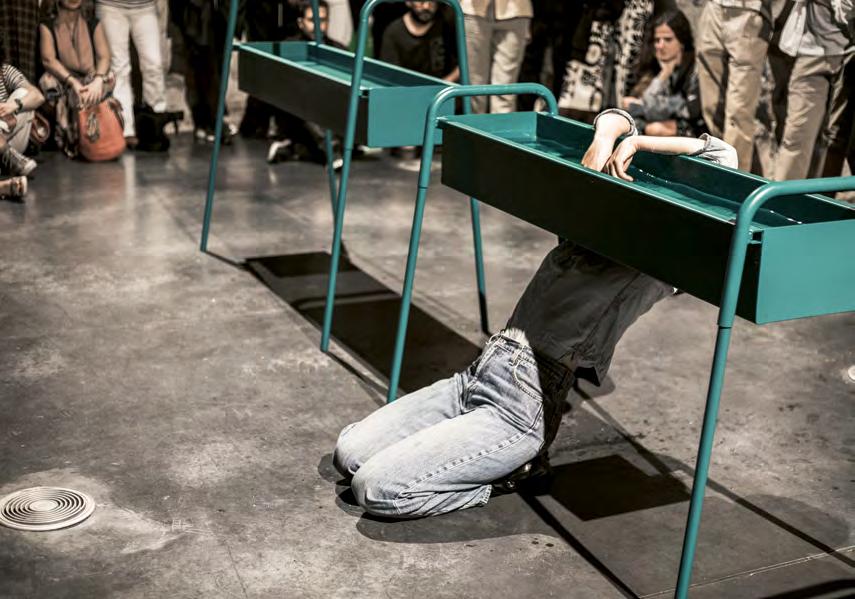







LIED 2019
(with Xavi Lloses) Performance: collaborative, amplified, 45 min.
First presentation: Konvent, Berga, June 1, 2019
Produced by: Konvent, Laia Estruch, Xavi Lloses
Audio production: Xavi Lloses
Following presentations: Barcelona Poesia, Centre Cívic Convent de Sant Agustí, Barcelona, May 14, 2021
CROL
2019 – 20
(Crawl) With Crol, Estruch deepened her exploration of the acoustic and expressive potential of the voice in water. In a performance that began with a literal deep dive into the
Montjuïc Municipal Pool, the diving venue at the 1992 Barcelona Olympics, Estruch floated and swam among inflatable elements resembling large chain links and mooring buoys while reciting verses and experimenting with extended vocal techniques, such as the cant redoblat, a throaty vibrato characteristic of the traditional songs of Ibiza and Formentera.
As a counterpoint to this “wet” work, a “dry” exhibition featured the inflatables stored alongside a sound installation and railing sculptures reminiscent of pool railings or distorted ballet barres (Crol Barana-1 and -2). In Crol Estruch approached public pools as environments for athletic and artistic exercise, but also emphasized the democratic potential of these leisure spaces and how their weightless freedom can benefit awareness of our own bodies and encompass both joyful and fearful experiences.
Sculpture: Crol Cadena (Crawl Chain), 22 parts, polyester and PVC fabric, 6 beige: 250 × 175 × 40 cm, 6 blue: 200 × 150 × 40 cm, 5 blue: 250 × 175 × 40 cm, 5 beige and blue: 300 × 185 × 40 cm; Crol Anunci (Crawl Announcement), polyester and PVC fabric, 250 × 40 × 40 cm; Crol Barana-1 (Crawl Railing-1), painted steel, 150 × 300 × 9 cm; Crol Barana-2 (Crawl Railing-2), painted steel, 197 × 200 × 9 cm; Tanc (Tank), 2020, polyester and PVC fabric, 300 × 125 × 40 cm
Performance: Crol (Moll) (Crawl [Wet]), solo, amplified, approx. 45 min.; solo, unamplified; Crol (Sec) (Crawl [Dry]), approx. 45 min.; Tanc, 2020, solo, amplified, approx. 45 min.
Audio: Crol Cançó (Crawl Song), 17 min.
Video: Crol Moll, 31:11 min.
First presentation: “Gira tot gira” series, Espai 13, Fundació Joan Miró, Barcelona, September 20–
December 8, 2019 (sculptures
Crol Cadena; Crol Anunci, Crol Barana-1 and -2; audio Crol Cançó; performance Crol (Sec): November 28, 2019); Montjuïc Municipal Pool, Barcelona, September 30, 2019
(sculpture Crol Cadena, Crol Anunci; performance Crol [Moll] )
Produced by: Fundació Joan Miró
Curated by: Marc Navarro
Fabrication: Tecnodimensión, Taller d’escenografia Teatre-Auditori
Sant Cugat
Audio production: Aleix Clavera, Xavi Lloses, Carles Prats
Video production: Arnau Mata
Graphic design: Setanta
Following presentations:
Festival Sâlmon, Piscines Bernat Picornell, Barcelona, February 16, 2020 (sculptures Crol Cadena and Crol Anunci; sculpture and performance Tanc)
En otro tiempo ibas muy elegante, Galería Ehrhardt Flórez, May 8–June 6, 2021, Madrid (Crol Barana-2)
Kinu#9, Azkuna Zentroa, Bilbao, December 15, 2022 (sculptures Crol Cadena and Crol Anunci; performance Crol [Moll] )
Atoi, Bilbao, December 17, 2022–January 6, 2023 (sculptures Crol Barana-1 and -2; performance Crol (Sec): December 17, 2022)
Uno Dos Tres, Galería Ehrhardt Flórez, Madrid, May 11–June 1, 2024 (Crol Barana-2)
Habitaciones, Galería Travesía Cuatro, Guadalajara, Mexico, September 26–December 14, 2024 (sculpture Crol Barana-2)






Caus a l’aigua i és com ciment a les rajoles hi passo els dits de les ungles de peix a les rajoles hi veig persones i ocells
Les cames anaven baixant les cames calentes entren i es donen soles i s’obren toves es fan amples els dits t’agafes als seus bracets i l’aire marxa per sota L’aigua va arran del carrer i és com la carn l’aigua s’agafa dins del forat veus la Ramona que ja ha entrat a l’aigua on tot és fantasia l’aigua s’agafa dins del forat quan obres la boca l’aigua entrena els cossos cansa els cossos
El gemec humit que només escolta la balena ajunta les baves cap avall i allisa els cabells enrere Mous la Novena de la Soca a l’arrel que et treurà el mal que tens
La cadena és tova i bona com quan ets petita i t’estàs fent la Tralla xopa s’allarga com un fil de sang a l’aigua
Ja no enfonso el cap dins l’aigua
el trec de l’aigua el cos sencer busca la por qui puja no busca la por
A les rajoles si no són llises del tot sempre hi veig figures amb el cos lluent tallava l’aigua avall tot era diferent
Passa’m les guies el reflex del casc és llis la bèstia quadrada empenyent i abraçant alhora
El cos sencer és un cap, pala o tronc
la Tralla que sento dins, xopa, és un cordill com un fil de sang a l’aigua
El gemec enganxat a les parets de la gola
You fall into the water and it’s like concrete
I run my fingers with fish nails over the tiles
I see people and birds on the tiles
The legs were going down the hot legs enter and they give themselves alone and open soft and the fingers spread out wide you cling to her little arms and the air flows out below The water flows at street level and it’s like flesh
the water clings inside the hole you see Ramona who has already entered the water where everything is fantasy the water clings inside the hole when you open the mouth the water trains bodies it tires bodies
The damp moan that only the whale hears it gathers the drool downward and smooths the hair backward
You move Novena from Soca up by the roots that will remove the affliction you have
The chain is good and soft like when you are small and forming the soaked Tralla stretches out like a thread of blood in the water
I no longer plunge my head into the water
I take it out of the water the whole body seeks fear whoever rises does not seek fear
On tiles that are not perfectly smooth I always see shapes with my gleaming body I cut through the water below everything was different Pass me the guides the reflection of the helmet is smooth the square beast pushing and embracing at the same time
My whole body is a head, spade, or trunk
the Tralla I feel within, soaked, is a cord like a thread of blood in the water
The moan stuck to the walls of the throat

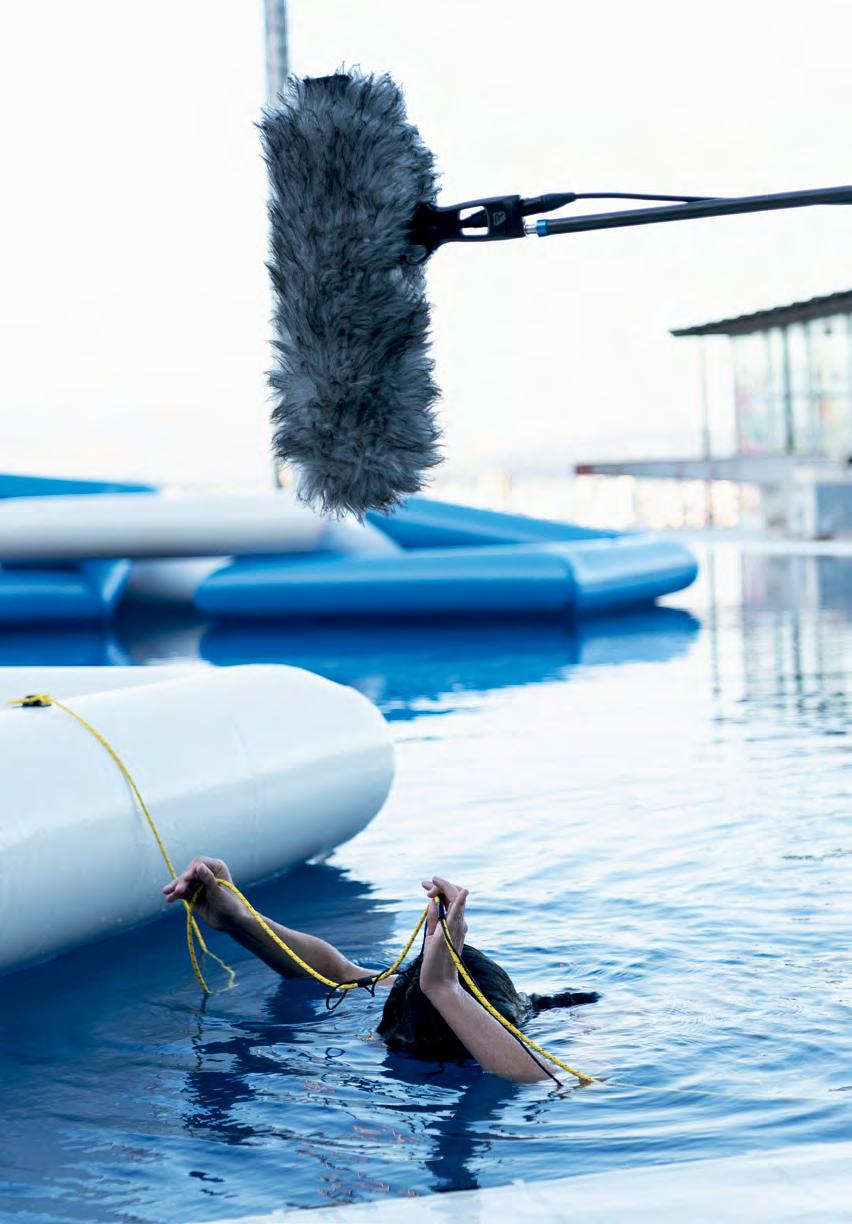


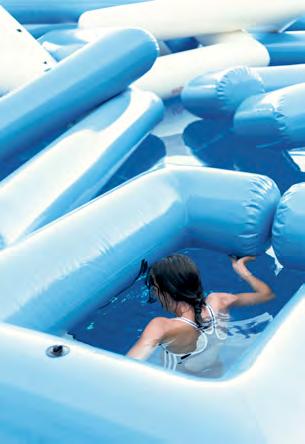






(Knife) Ganivet comprised a series of performance rehearsals developed on a metal sculpture shaped like two axe-heads joined at their blades. The project’s point of departure was the work of Joan Brossa, its fusion of theater, literature, visual and graphic arts, and in particular the “PoemObjects” (created primarily during the 1960s and 1970s) he conceived as poetry expressed through the juxtaposition of everyday objects. The sculpture was originally suspended by its four corners from the ceiling in a gallery of the Fundació Joan Brossa in Barcelona. Its ramps served as stage entrances or exits and it became an unstable setting for vocal improvisations by Estruch and also, unexpectedly, a percussion instrument she could clamber across, learn to play, and coax language from. The welded marks that appear like hieroglyphics or scarification on the sculpture’s skin reference Brossa’s visual poetry while functioning as a type of tactile notation.
Sculpture: painted steel, anchorages, 740 × 350 × 43 cm overall, no longer extant; Ganivet, partial reconstruction, 2025, painted steel, 370 × 175 × 43 cm
Performance: solo, unamplified, with sculpture, approx. 35 min.; open public activation, with sculpture
Audio: Ganivet, 7″-vinyl edition, 2 parts, “Performance (1)—01/12/2020: A” (5:03 min.), “B” (5:15 min.)
Video: 30 min.
Presented at: Fundació Joan Brossa, Barcelona, September 16, 2020–July 18, 2021 (sculpture; solo performances: September 30 / November 4 / December 19, 2020; open public activations: November 14, 2020 / January 30, 2021)
Coordination: Judith Barnés
Fabrication: Taller d’escenografia TeatreAuditori Sant Cugat
Audio production: Pablo Miranda
Video production: Arnau Mata
Graphic design: Oficina de disseny (Ariadna Serrahima, Diego Bustamante)




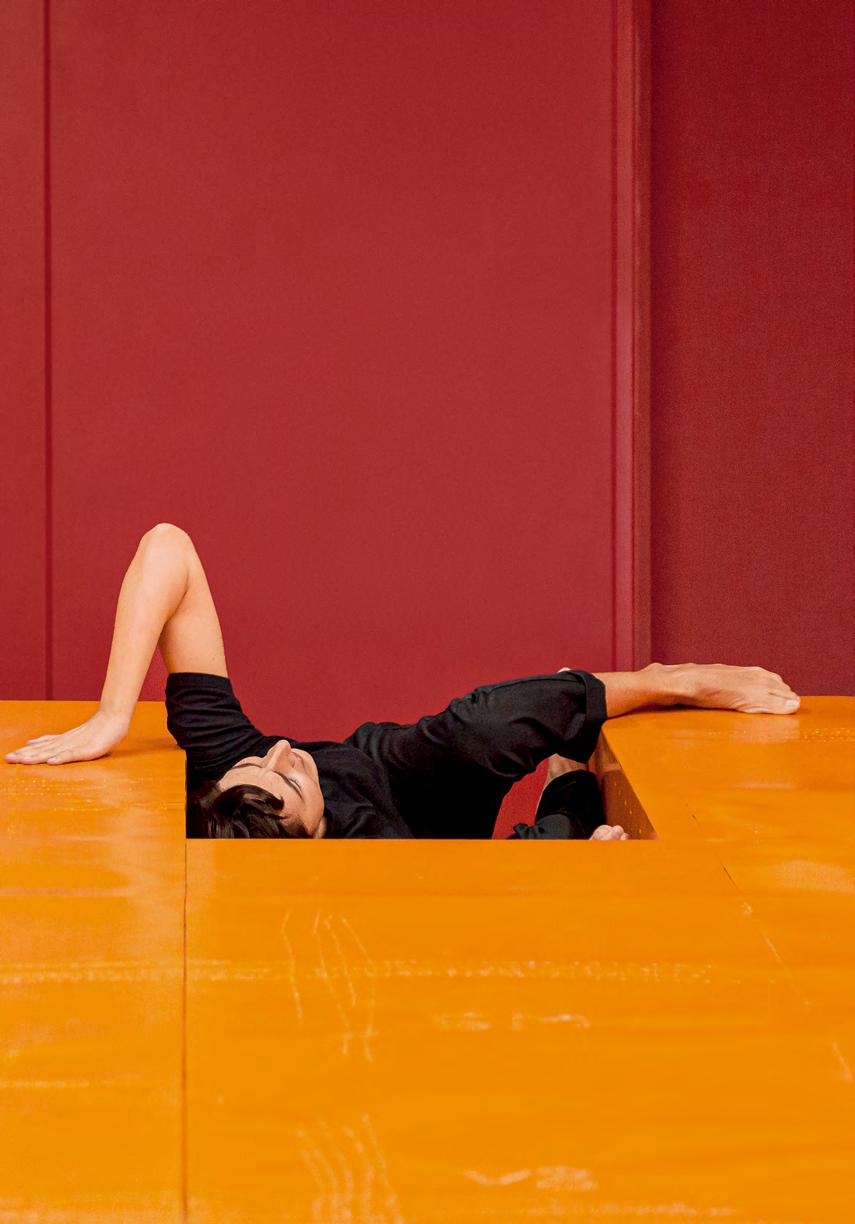


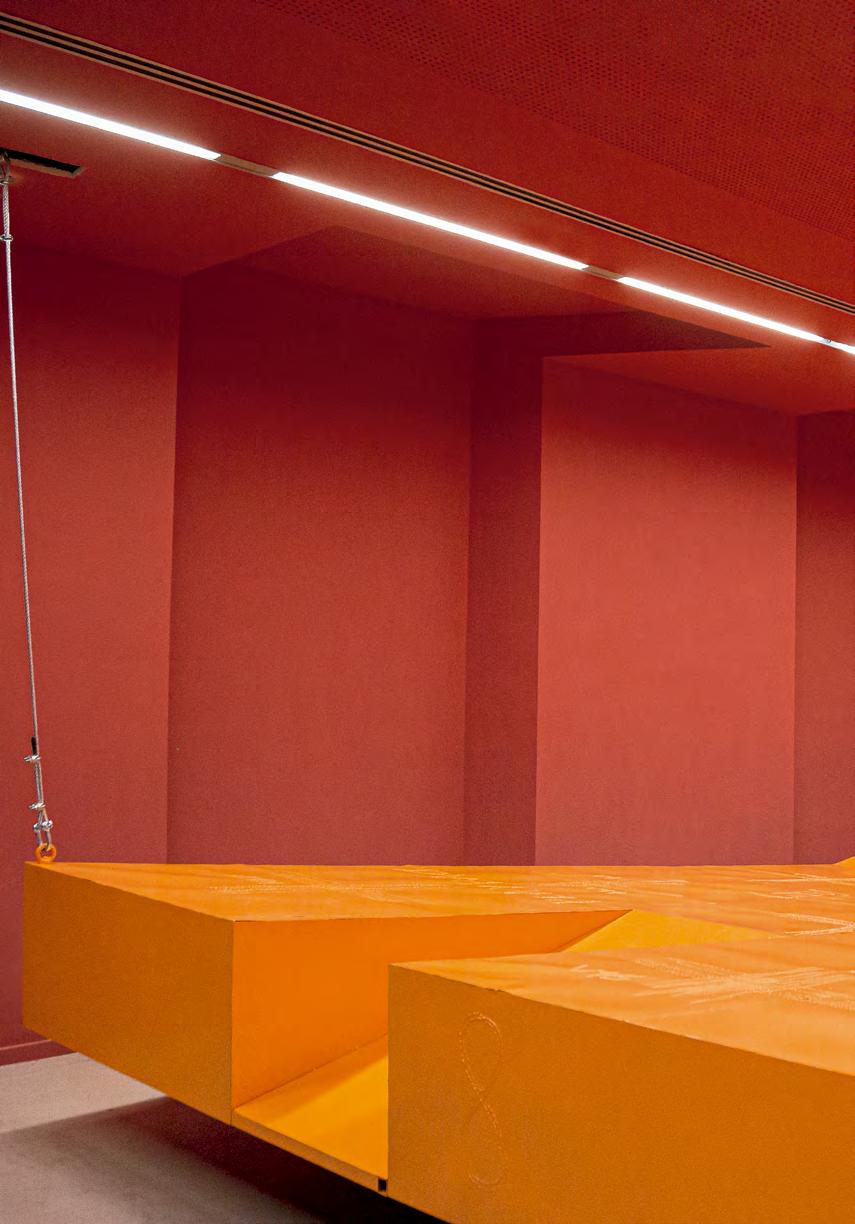


CANTAR L’AIGUA
(Sing the Water) (with Marc Vives)
Performance: collaborative, amplified and unamplified, approx. 45 min.
Presented at: Creació i Museus, MUHBA
Casa de l’Aigua, Barcelona, October 17–18, 2020
Produced by: La Caldera, Museu d’Història de Barcelona (MUHBA), Festival Grec
With the collaboration of: Arnau Sala Saez, Matilde Amigo, Xavi Lozano



CLOS/SOLC
2020
Performance: solo, amplified, approx. 3 min.
Video: 2:37 min.
Presented at: Marçalianes. “Prenc el camí que m’ha portat a tu,” Centre de Cultura Contemporània de Barcelona (CCCB) (video: November 26, 2020)
Produced and coordinated by: CCCB, La Sullivan, Fundació Maria-Mercè Marçal
Video production: Mireia Calafell
MIX 2021
Mix is an ever-evolving performance in which Estruch creates a live edit of her extensive repertoire of vocal registers, modulations, and mannerisms of spoken and sung sounds that she has developed and acquired over the course of her projects. Stripped of the accompanying sculptures that would have facilitated these vocalizations through their various forms and material qualities, the performances are highly structured exercises in auditory and muscular memory. Estruch brings forth past voice sensations and learned behaviors, rearticulating sounds previously accessed and produced in entirely different performance settings. Mix is an active process of pulling fragments from a living archive and reshaping, recontextualizing, and reassembling them in real time.
By bringing together sounds with distinct histories and origins, Mix can be seen as an extension of the sonic collage technique found in musique concrète. Yet unlike the fixed nature of tape splicing, which cuts and edits sounds recorded in a physical media, Mix is an in-person practice that results in unique expressions each time and aligns more closely with traditional storytelling practices where spoken words might intertwine with melody and oral history. With the repetition and retelling of Estruch’s own past experiences through her diverse utterances, Mix preserves a form of personal cultural heritage while reinforcing her community of sounds.
Performance: solo, amplified, approx. 25 min.
First presentation: Domingo, La Casa
Encendida, Madrid, June 15–27, 2021
(performance: June 25, 2021)
Produced by: La Casa Encendida
Curated by: Fernando Gandasegui
Following presentations:
Festival TNT, Nova Jazz Cava, Terrassa, October 2, 2021
PUBLICS, Helsinki, March 17, 2022
Límbic Festival, Torre del Palau, Terrassa, May 27, 2022
Crisp-Ellert Art Museum, St. Augustine, Florida, October 27, 2023
La Fragua. Artist Residency, Fundación Botí, Córdoba, Spain, January 13, 2024
Festival Plataforma, MAS – Museo de Arte Moderno y Contemporáneo de Santander y Cantabria, Santander, October 20, 2024





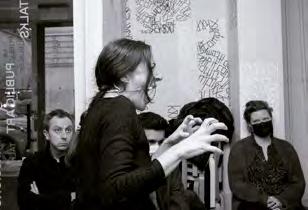

(Siren) Following Sibina and Crol, Estruch revisited the notion of the aquatic voice with Sirena. This project featured a water-filled sculpture resembling a partially covered industrial bath or outsized gutter. Equipped with microphones and hydrophones, the sculpture captured Estruch’s vocalizations as she performed while immersed in the water and as she attuned herself to the sloshing and creaking sounds produced by exploring the resonant structure.
Developed in collaboration with author Irene Solà, Sirena drew from the Greek mythology of sirens— female creatures whose bewitching voices lure sailors to peril—and their folkloric evolution into the fairytale stereotype of the mermaid who trades her voice for human legs in order to leave her underwater world and pursue a prince. Estruch and Solà sought to subvert these tragic portrayals of the female voice as destructive or sacrificial, instead drawing on analogies of amplification, and eschewing narrative entirely, to highlight the voice’s capacity for empowerment as well as vulnerability.
Sculpture: Sirena, painted steel, water, two elements, 63.2 × 55.3 × 200 cm overall
Performance: solo, amplified, approx. 40 min.
First presentation: Hivernacle del Palau, Palau de la Música Catalana, Barcelona, September 16/19, 2021
Produced by: Palau de la Música Catalana
With the collaboration of: Irene Solà
Fabrication: Taller d’escenografia TeatreAuditori Sant Cugat
Audio production: Xavi Lloses
Following presentations: El verbo harmónico, Centre d’Art la Panera, Lleida, March 5–May 22, 2022 (sculpture; performance: May 14, 2022)
Ones/Olas/Waves, Casal Solleric, Palma de Mallorca, July 27–October 29, 2023 (sculpture; performance: July 27, 2023)







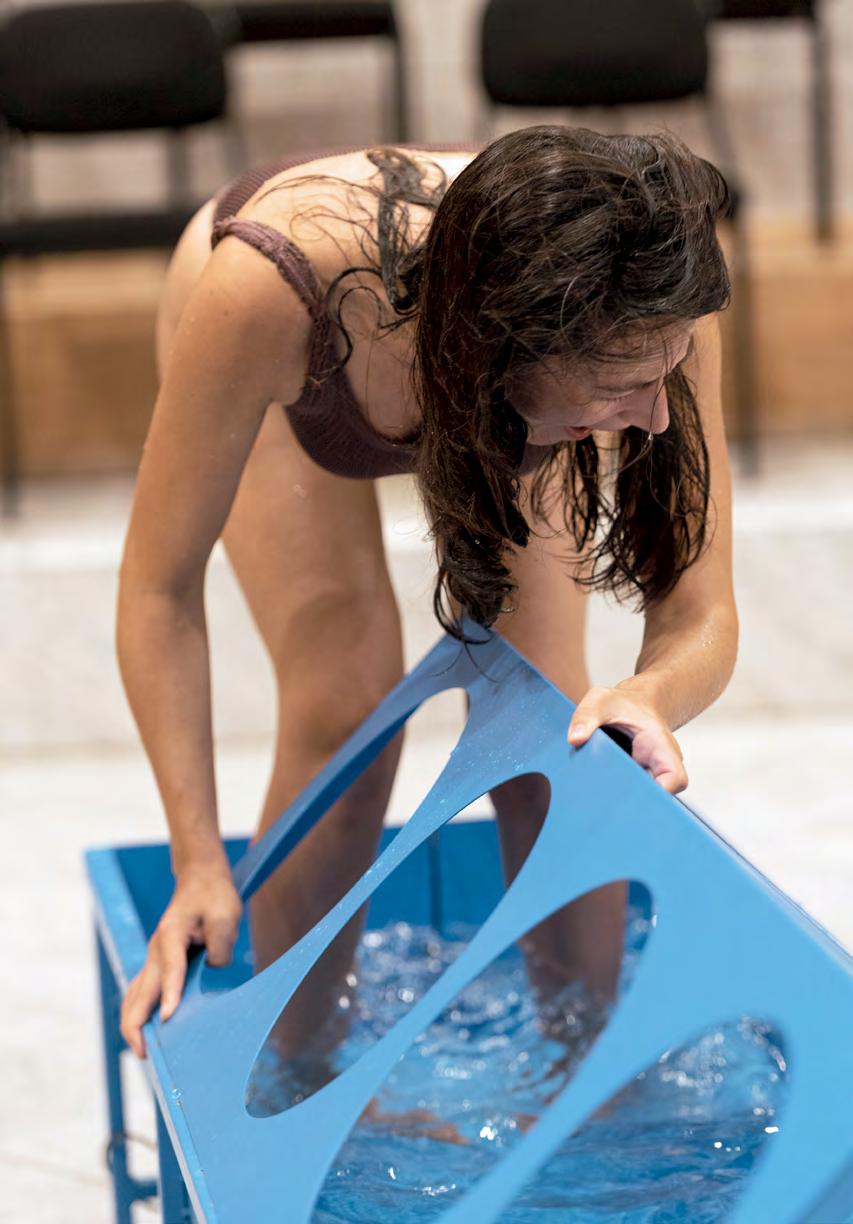
Performance: solo, unamplified, approx. 20 min.
Presented at: Bianyal 2021, La Vall de Bianya, October 9–10, 2021 (performance: October 10, 2021)
Produced by: Ajuntament de la Vall de Bianya
Curated by: Associació Cultural Binari



OCELLS PERDUTS
2021–22
(Stray Birds) Developed during the Covid-19 pandemic, when breath itself became a risk and human movement was restricted, Ocells perduts departed from Estruch’s attempts to transform her voice toward a state of altitude, mobility, and airborne freedom by approximating the songs and calls of birds. In its original presentation, a
vast netlike sculpture and walkway, suspended high above the ground like a tree-borne trap, served as a stage for a series of live rehearsals by the artist. These performances drew on the vocalizations and dispositions of birds that nest in Barcelona and winter in sub-Saharan Africa, such as the golden oriole, the turtle dove, and the wryneck. Complementing the red net, a blue-and-yellow windsock attached to a fan served as an advertisement and branding for the performances, while evoking the birds’ migratory flyways by adopting the form of the instruments used at airports to gauge wind direction and intensity.
Ocells perduts (2021)
Sculpture: Ocells perduts (xarxa i pont) (Stray Birds [Net and Bridge]), netting and steel cable bridge (approx. 50 × 156 × 1365 cm), suspended netting, steel cable lifeline, 3 stabilizing bars, anchorage plates, tensors, and fixings (approx. 400 × 500 × 1365 cm overall); Ocells perduts (braç de vent) (Stray Birds [Windsock]), nylon, metal mounting, fan, timer (approx. 40 × 70 × 400 cm)
Performance: solo, unamplified, 25–45 min. Audio: sound installation, approx. 25 min. loop
First presentation: Panorama 21. Apunts per a un incendi dels ulls, Museu d’Art Contemporani de Barcelona (MACBA), October 22, 2021–February 27, 2022 (sculpture; audio; performances: November 20 / December 18, 2021, January 29 / February 26, 2022)
Produced by: Museu d’Art Contemporani de Barcelona; PUBLICS, Helsinki
Curated by: Latitudes, Hiuwai Chu
Coordination: Berta Cervantes
Fabrication: Tecnodimensión, El Remitger, Temp Metal
Technical assistance: Eva Font, Eskubi Turró Arquitectes
Audio production: Pablo Miranda
Graphic design: Setanta
Following presentations:
Galería Ehrhardt Flórez, ARCOmadrid, IFEMA, Madrid, March 6–10, 2024 (sculpture Ocells perduts [braç de vent] )
Habitaciones, Galería Travesía Cuatro, Guadalajara, Mexico, September 26–December 14, 2024 (sculpture Ocells perduts [braç de vent] )
Ocells perduts V67 (2022)
Performance: solo, unamplified, approx. 35 min.
Audio: sound installation, approx. 25 min. loop
First presentation: Pasaje del agua, TBA21, various venues, Córdoba, Spain, June 3–5, 2022 (performance: June 5, 2022)
Produced by: TBA21 | ThyssenBornemisza Art Contemporary
Curated by: Sofia Lemos, Daniela Zyman
Costume design: Onrush23FH
Following presentations:
El meu cos coneix cants inaudits, la carn diu ver, soc carn espaiosa que canta, Bòlit Centre d’art contemporani, Girona, February 10–April 30, 2023 (audio; performance: April 29, 2023)
Bebí palabras sumergidas en sueños, 23 Bienal de Arte Paiz, La Nueva Fábrica, Antigua Guatemala, July 13–30, 2023 (audio; performance: July 15, 2023)
Errant festival, Llavorsí (performance: July 21, 2023)
El que queda després, Església de Sant Llorenç, Mèdol – Centre d’Arts Contemporànies de Tarragona (performance: November 24, 2023)
Accions Sonores, Sala Busquets, Escola Massana. Centre d’Art i Disseny, Barcelona (performance: February 15, 2024)
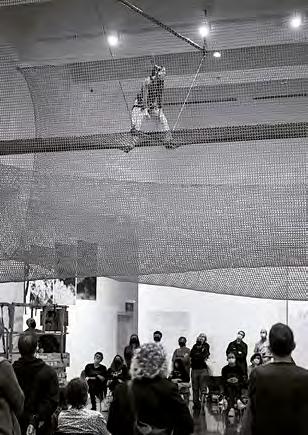







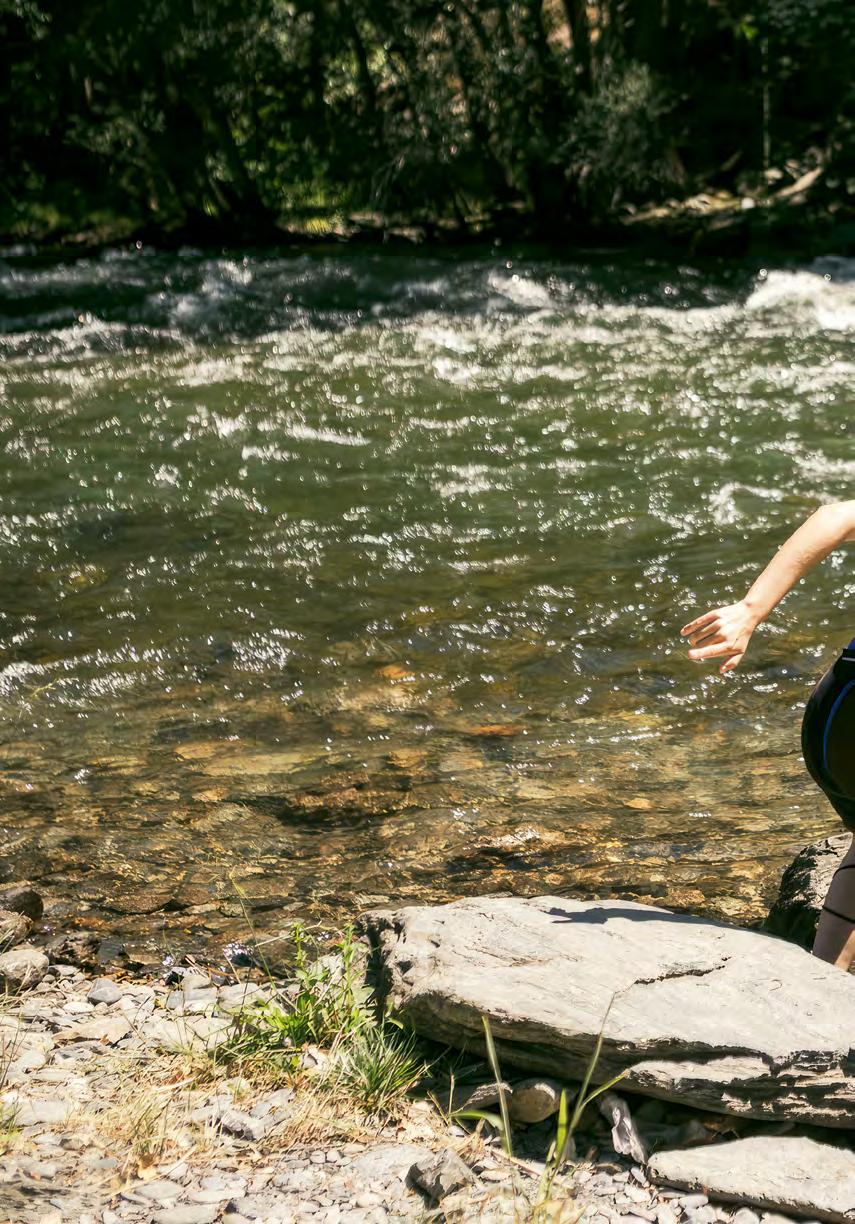


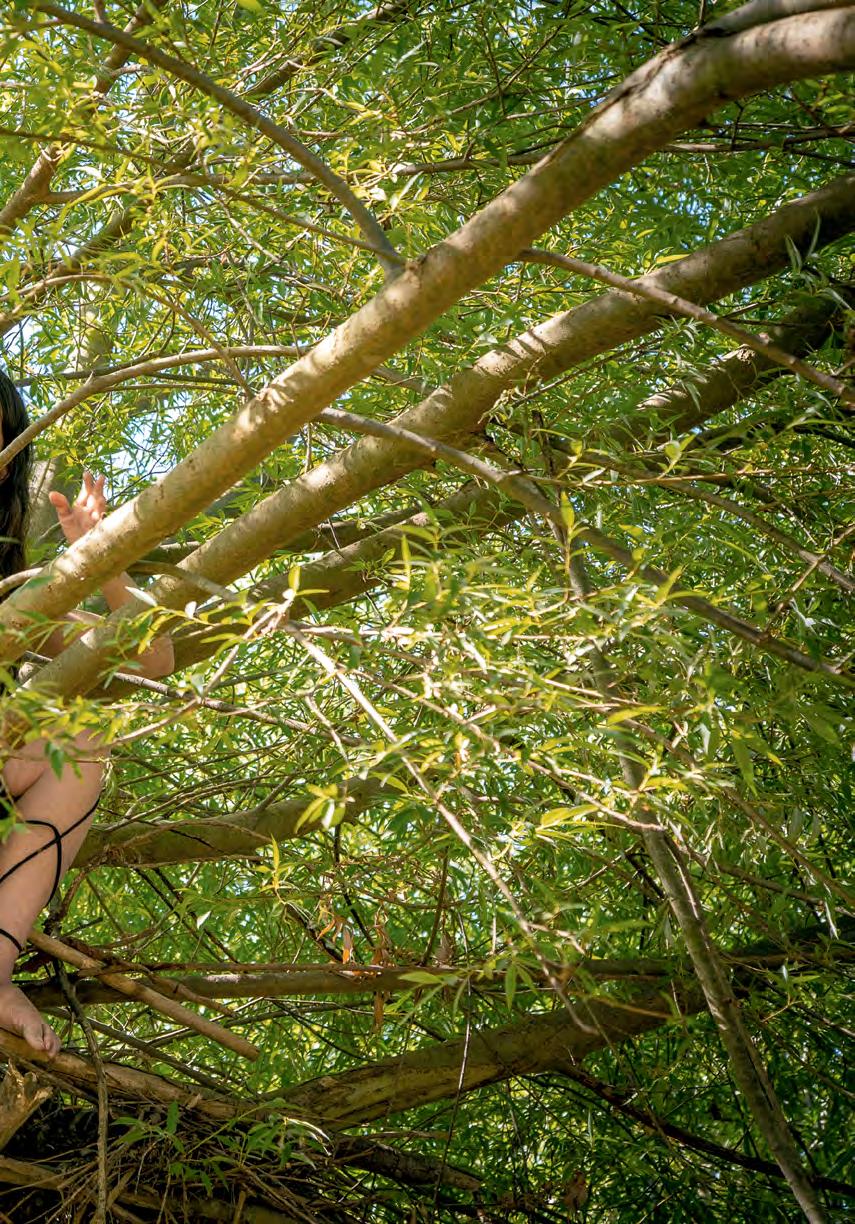




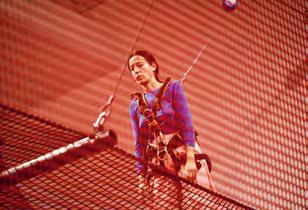

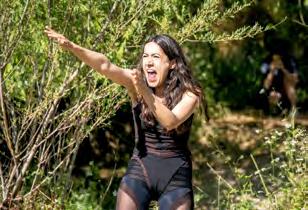

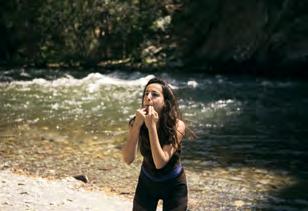
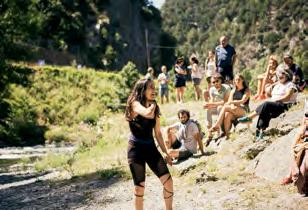
(Baseboard) Zócalo is a ceramic sculpture reminiscent of an ornamental water main or a large jointed wind instrument that Estruch performs by playing, touching, reading, and interpreting its cylindrical form.
Apertures and protuberances cut out and molded from the once malleable clay of this rudimentary body create peepholes, mouthpieces, or shaped grips, while inscriptions suggest a possible score for movement or action. For example, “RI” refers to rodilla izquierda (left knee), and “OLB” to ojos-luz-boca (eyes-light-mouth).
Following a dual invitation to partner with a master craftsman and to conduct research in Granada, Estruch chose to develop Zócalo with the Catalan ceramicist Eloi Bonadona. While her Granada research focused on water supply structures in Al-Andalus architecture and the geometric skylights of the Hammam al-Yawza, or Bañuelo—a former public bathhouse dating to the twelfth century—Bonadona brought his expertise in the grayware pottery tradition of the town of Quart, near Girona, known especially for its large, decorated cossis —washbasins adorned with undulating bands.
Sculpture: Zócalo, ceramic, 60 × 60 × 426 cm
Performance: solo, unamplified, with sculpture, approx. 25 min.
Video: 8:42 min.
Audio: sound installation, 10 min. loop
First presentation: VI Premio Cervezas Alhambra de Arte Emergente, ARCOmadrid, IFEMA, Madrid, February 23–27, 2022 (sculpture; performances: February 25, 2022)
Produced by: Premio Cervezas Alhambra de Arte Emergente
With the collaboration of: Eloi Bonadona
Fabrication: Bonadona Terrissers
Audio production: Pablo Miranda
Video documentation: Arnau Mata, Luis Bezeta
Following presentations: 10° Festival Deleste, Bombas Gens, Valencia, May 27–29, 2022 (performance: May 26, 2022) Artesanía y arte contemporáneo. Premio Cervezas Alhambra de Arte Emergente, Sala de Armas de la Ciudadela, Pamplona, May 16–June 30, 2024 (sculpture)
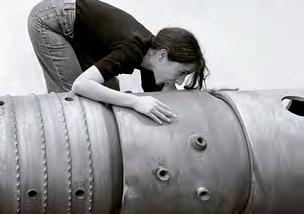


2022–23
Improvisación-1 (Improvisation-1) (2022)
Performance: solo, unamplified, approx. 30 min.
Presented at: Si las palabras hablaran, Fundación Sandretto Re Rebaudengo Madrid, May 27–June 25, 2022 (performance: May 28, 2022)
Produced by: Fundación Sandretto Re Rebaudengo Madrid Young Curators Residency Programme
Curated by: Laura Castro, Emily Markert, Ludovica Bulciolu
Coordinated by: Ana Ara
Improvisación-2 (Improvisation-2) (2022)
Performance: solo, unamplified, approx. 30 min.
Presented at: Estudis sobre l’horitzó, AA+AA, Arbar Centre d’art i Cultura, La Vall de Santa Creu, August 6, 2022
Produced by: Arbar Centre d’art i Cultura
Curated by: Eduard Escoffet
Improvisación-3 (Improvisation-3) (2022)
Performance: solo, amplified and unamplified, approx. 30 min.
Presented at: Posibilidades de escucha: análisis y propuestas desde las prácticas artísticas, XIV Curso de Cultura Contemporánea, Fundación Cerezales Antonino y Cinia, Cerezales del Condado, September 17, 2022
Produced by: Fundación Cerezales Antonino y Cinia, MUSAC. Museo de Arte Contemporáneo de Castilla y León Coordination: Eneas Bernal, Koré Escobar, Zaida Llamas, Alfredo Puente, Luis David Rivero
Improvisación-4 (Improvisation-4) (2022)
Performance: solo, unamplified, approx. 30 min.
Presented at: Si no vols pols no vinguis a l’era / Acció 4, Espai nyamnyam, Mieres, August 26, 2022
Produced and curated by: nyamnyam
Improvisación-5 (Improvisation-5) (2023)
Performance: solo, amplified, approx. 30 min.
Presented at: Picasso 2023 / Tàpies 2024 / Miró 2025, Saló del Tinell, Barcelona, March 2, 2023
Produced by: Ajuntament de Barcelona, Generalitat de Catalunya, Museu Picasso, Fundació Antoni Tàpies, Fundació Joan Miró
Curated by: Vicenç Altaió
Costume design: Rosa Tharrats
Improvisación-6 (Xiulets) (Improvisation-6) (Whistles) (2023)
Performance: solo, unamplified, approx. 15 min.
Presented at: Memòria personal. Vuit gestos per a una biografia, Fundació Antoni Tàpies, Barcelona, December 13, 2023
Produced by: Fundació Antoni Tàpies



Residua centers on two sinuous sculptures that resemble playground slides, marked with coded inscriptions—numbers, letters, and symbols welded into their surfaces. The form of the sculptures also brings to mind the tilde (~), an accent mark modifying pronunciation and a stand-alone symbol meaning approximately. The title Residua is lent by a collection of short, highly condensed texts by the Irish avantgarde author Samuel Beckett, written between 1956 and 1971, including “Ping” (1966), whose hypnotic language evokes a barely conscious body confined in a white space.
By performing and temporarily inhabiting this sculpture-scenography, Estruch explores how it adapts to the movements of her body and her voice, and, correspondingly, how she reacts to its anatomical qualities and communicative timbre—whether by dragging her feet over it or responding to its metallic expressions. Residua’s companion “announcements” adopt the form of outsized street flyers with tearoff strips, while related audio works explore the sonic alliances between voice and cymbal.
Sculpture: Residua, painted steel, 2 parts, 295 × 726 × 50 each;
Anunci Residua A (Announcement Residua A), stainless steel, 207.5 × 150 cm; Anunci Residua B (Announcement Residua B), stainless steel, 150 × 92.5 cm
Performance: solo, unamplified, with sculpture Residua, approx. 35 min.
Audio: Reflexiones Impro Plato, 22 julio 2022 (Cymbal Improv Reflections, July 22, 2022), sound installation, 20:44 min. loop; Reflexiones Copicat, 22 julio 2022 (Copycat Reflections, July 22, 2022), sound installation, 10:33 min. loop
First presentation: Galería Ehrhardt Flórez, Madrid, September 8–
November 5, 2022 (sculpture; audio; performances: September 8 / September 10 / October 7 / November 5, 2022)
Produced by: Galería Ehrhardt Flórez
Fabrication: Taller d’escenografia TeatreAuditori Sant Cugat
Audio production: Pablo Miranda
Following presentation: El Mediterráneo: Un mar redondo, ARCOmadrid, IFEMA, Madrid, February 22–26, 2023 (sculpture Residua; performance: February 23, 2023)



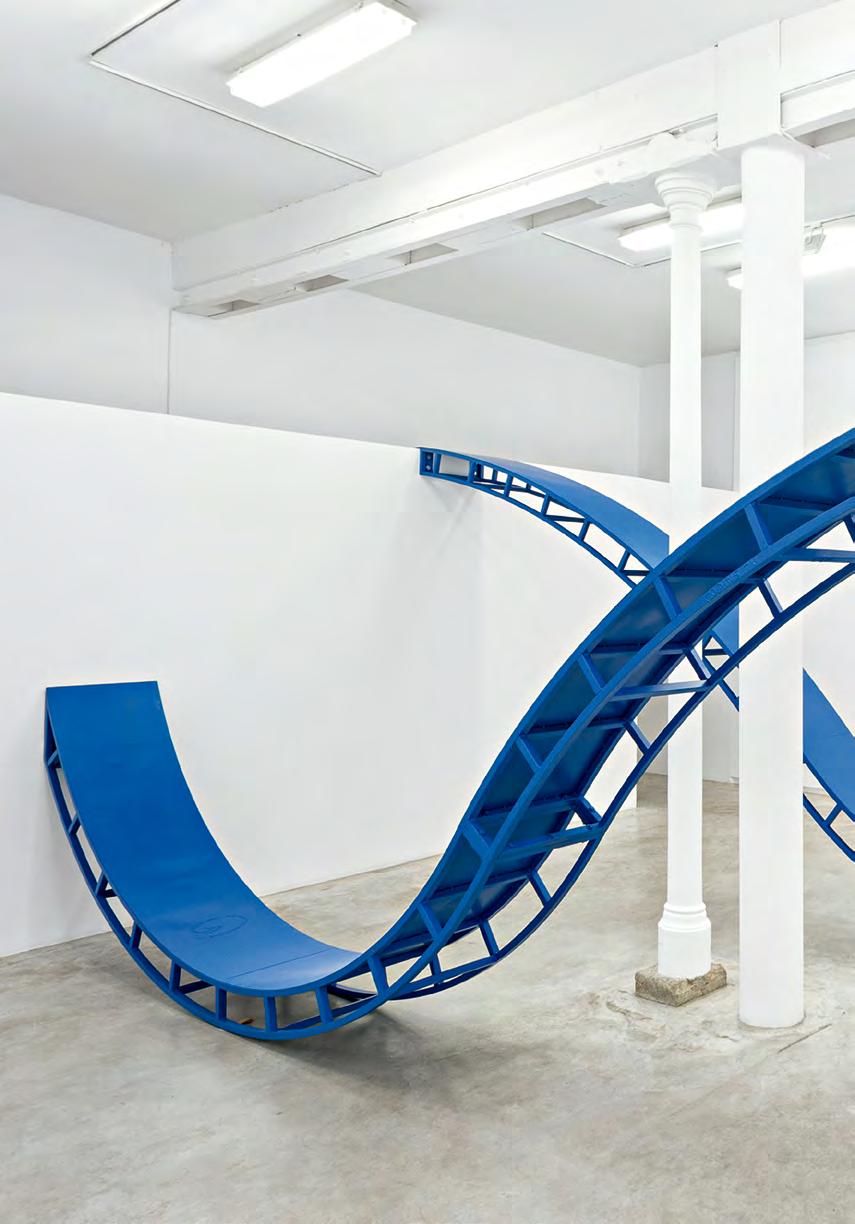

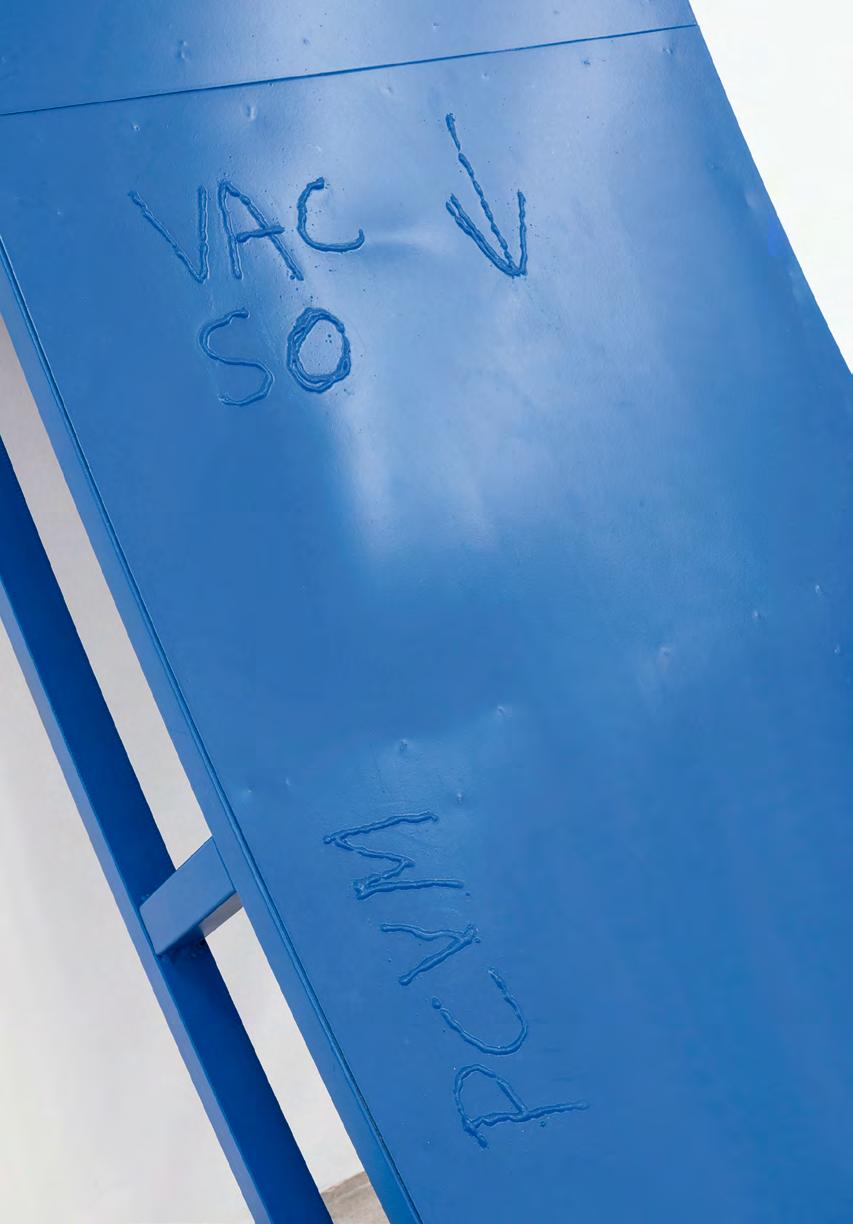
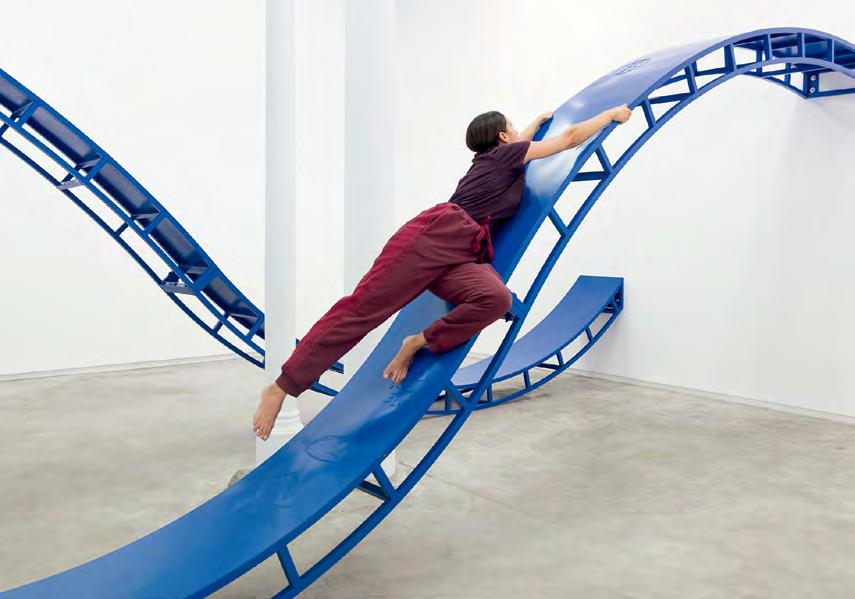
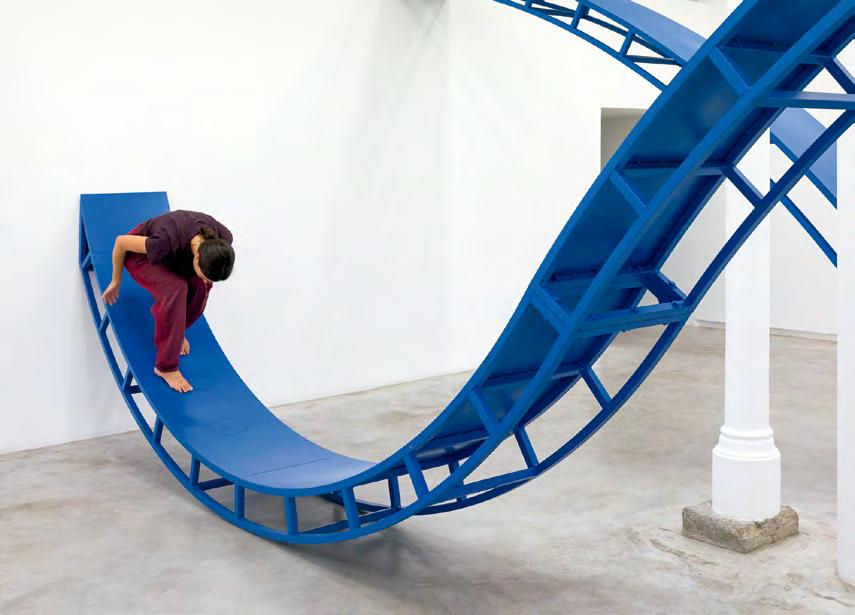
With dozens of painted figures dating back to the last hunter-gatherers 10,000 years ago, and hundreds of rock engravings from the Neolithic period, the Roca dels Moros at El Cogul, near Lleida, is one of the most significant prehistoric sites on the Iberian Peninsula. Hute was conceived as a live soundtrack for this landscape, emerging as Estruch wound her way across an escarpment adjacent to the cave site itself, beside the Set River. In the performance, she “translated” the graphic expressions of the paintings and engravings into voice and gesture, drawing from her tactile connection with the rocky terrain, her perception of the nearby water’s currents and the breath of the wind, and reimagining them in sound. Hute also speculated on the unknowable ancestral spoken language of the men and women who created these prehistoric images and writings, reflecting on how vocalization would have evolved from acts of naming things, expressing needs, and giving simple orders to one another and to animals (the title Hute evokes a command used by local herders) into an incredibly complex medium capable of shaping cultural memory.
Performance: solo, amplified, approx. 35 min.
Audio: sound installation, 31:12 min. loop
Video: 10:16 min.
Presented at: Passat / Present, Centre d’Interpretació d’Art Rupestre de la Roca dels Moros del Cogul, El Cogul (performance: September 25, 2022)
Produced by: Generalitat de Catalunya, Departament de Cultura
Curated by: Frederic Montornés
Audio production: Pablo Miranda
Video production: Anna Fàbrega




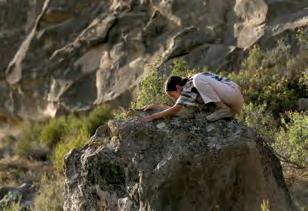
(Crossovers) (with Amalia Fernández)
Performance: collaborative, amplified and unamplified, approx. 100 min.
Presented at: Cruzadas #2, Fabra i Coats: Centre d’Art Contemporani, Barcelona, December 3, 2022
Produced by: La Poderosa, Fabra i Coats: Centre d’Art Contemporani
Coordination: Bea Fernández, Mónica Muntaner, Joana Hurtado



The Kite series is a form of research— through multicoloured textile sculptures and performances—into the interaction between natural wind currents and the airflows produced by the human voice. Held in tension between walls or trees, the sculptures
form taut yet fluid stages that emulate the aerodynamic function of small sails designed to harness the wind’s dynamics to lift or propel the body. Each work relates to the climate and landscape for which it was first conceived. Kite-1 draws inspiration from the mythology of the delirious effects of the persistent tramuntana wind in Catalonia’s Alt Empordà. Kite-2 reflects the orientation of the eight winds of Menorca, how their characteristics have shaped the island’s trading history, strategic importance, and daily life. Kite-4 refers to the sea breezes and El Norte winds of the Los Cabos region of Baja California Sur, Mexico, an area renowned for windsurfing and kitesurfing.
Kite-1 (2022)
Sculpture: HDPE fabric, polyester belt, steel cables, anchorages, approx. 286 × 698 × 400 cm
Performance: solo, unamplified, with sculpture, approx. 30 min.
Presented at: Spiritvessel, Espinavessa, December 11, 2022–April 28, 2023 (sculpture; performance: December 11, 2022)
Produced by: Spiritvessel
Curated by: Sira Pizà
Fabrication: Tecnodimensión
Kite-2 (2023)
Sculpture: HDPE fabric, polyester belt, steel cables, anchorages, 2 parts, approx. 300 × 800 × 500 cm overall
Performance: solo, unamplified, with sculpture, approx. 30 min.; open public activation, with sculpture
Presented at: After the Mediterranean, Hauser & Wirth Menorca, Maó, April 2–October 29, 2023 (sculpture; open public activation; solo performances: April 1–2, 2023)
Produced by: Hauser & Wirth Menorca
Curated by: Oriol Fontdevila
Fabrication: Tecnodimensión
Kite-3 (2024)
Sculpture: HDPE fabric, polyester belt, steel cables, anchorages, steel structure, approx. 300 × 200 × 50 cm
Produced by: Laia Estruch
Fabrication: Tecnodimensión
Kite-4 (2024)
Sculpture: HDGPE fabric, polyester belt, steel cables, anchorages, 2 parts, approx. 200 × 350 × 800 cm overall
Performance: solo, unamplified, with sculpture, approx. 30 min.
Presented at: El Patio by Zona Maco, ABC
Art Baja, San José del Cabo, Mexico, March 7–May 5, 2024 (sculpture; performance: March 8, 2024)
Produced by: Zona Maco
Curated by: Juan Canela, Lena Solà Nogué
Fabrication: Tecnodimensión
















(Braid) Trena was initially conceived for the Sala Oval of Barcelona’s Museu Nacional d’Art de Catalunya (MNAC). The first of Estruch’s projects to explicitly encourage public interaction, it comprised a thirty-five-meter-long plait of three interlaced pneumatic tunnels, with a central conduit inviting visitors to traverse its echoing interior. Inspired by the body’s circulatory, digestive, and respiratory systems, as well as subterranean networks and waterpark flumes, Trena explored the ceaseless flow of diverse elements— whether air, fluids, sounds, people, or data—across multiple scales within the fabric of the built environment. As with previous projects such as Crol (2019–20), the sculpture bore letters and numbers on its surface, inscriptions which functioned as an encoded date and location system, or a product serial number.
In Barcelona, the sculpture was envisioned as a type of public art, with the museum imagined as a town square meeting place. This concept was fully realized during Trena’s subsequent installation in the open-air setting of the Grote Markt, the central market square of Kortrijk, Belgium. Estruch was particularly interested in how town squares evoke a public arena that harkens back to earlier modes of community and common land, and how they can continue to function as sites of pure interactive potential.
Trena is completely reimagined for Laia Estruch: Hello Everyone at the Museo Reina Sofía. The tunnel skin is repurposed as a retractable curtain, dividing the largest gallery like partitioned warehouse storage. The tunnel entrances are transformed into an awning sculpture, while the ramp that once supported the walkway stands as a freestanding skeleton. The residual material is packed into two duffel sculptures.
Sculpture: Trena, polyester and PVC fabric, painted steel, 3 fans, approx. 3500 × 820 × 637 cm overall, no longer extant; Trena (Toldo) (Braid [Awning]), 2025, polyester and PVC fabric, painted steel, 660 × 150 × 110 cm; Trena (Cortina) (Braid [Curtain]), 2025, polyester and PVC fabric, steel, approx. 2680 × 315 × 495 cm; Trena (Pont) (Braid [Bridge]), 2025, painted steel, approx. 1675 × 705 × 280 cm; Trena (Farcells) (Braid [Duffels]), 2025, 2 parts, polyester and PVC fabric, dimensions variable
Performance: solo, amplified, with sculpture, approx. 35 min.; open public activation, with sculpture
Audio: sound installation, 2:10 min. loop
First presentation: Sala Oval, Museu Nacional d’Art de Catalunya (MNAC), Barcelona, July 7–September 3, 2023 (sculpture Trena; open public activation; solo performances: July 6 / September 2, 2023)
Produced by: Museu Nacional d’Art de Catalunya
Coordination: Alex Mitrani, Lluís Alabern
Technical assistance: Rationing
Fabrication: Tecnodimensión, Fàbrica de Creació La Brava
Audio production: Xavi Lloses
Following presentation: After Paradise, Kortrijk Triennial, Kortrijk, Belgium, June 29–October 6, 2024 (sculpture Trena; open public activation)
The works Trena (Cortina) and Trena (Toldo), included in the exhibition Laia Estruch: Hello Everyone, held at the Museo Reina Sofía, are new works produced on the basis of the project Trena, created in 2023 for the Sala Oval, in the Museu Nacional d’Art de Catalunya, Barcelona.











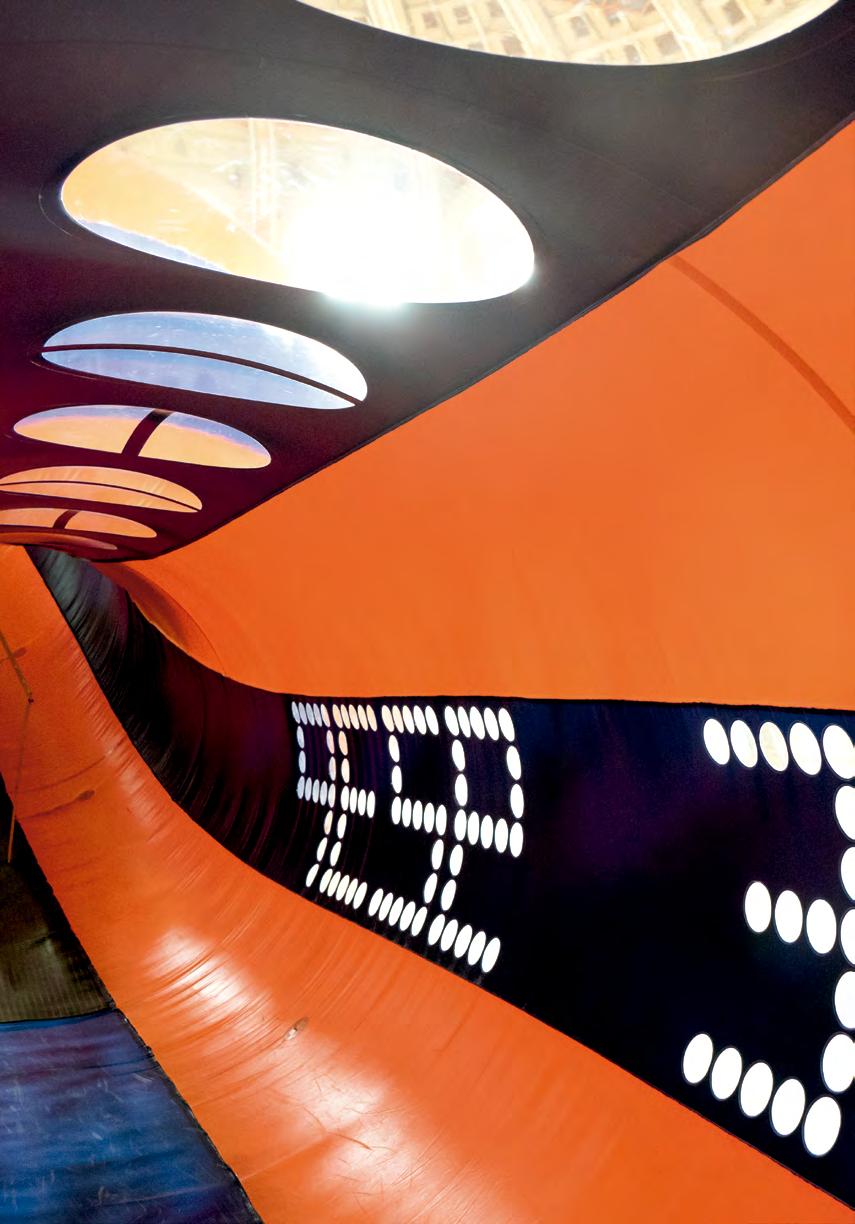


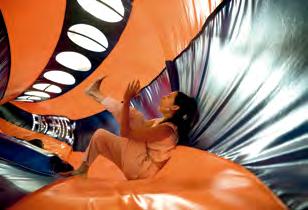







(Whale Voices) Performance: solo, unamplified, 35 min.
Presented at: O Afeto da Escuta, Galeria da Biodiversidade, Porto, November 10–12, 2023 (performance: November 11, 2023)
Produced by: Contemporary Art Department of Ágora, Cultura e Desporto do Porto
Curated by: Institute for Postnatural Studies



(Shout) Crit was a solo voice and movement performance that took place in the foothills of the Orlické Mountains in the Pardubice Region of the Czech Republic, an area of primeval forests and rolling meadows.
Drawing on cultures of pastoralism and transhumance, alongside ideas from acoustic ecology, Estruch evoked the sonic landscape of the surrounding environment, blending the natural, man-made, and mechanical voices that animate it. The performance drew particular inspiration from the shouts, calls, hollering, and whistling of herders—a coded communication that has developed over millennia between humans and the animals they tend and manage for labor or consumption, often across vast open landscapes. As the performance evolved, it segued from quiet, intimate sounds to ever louder and expansive expressions. Crit explored how tone, melody, and vocal intensity play a crucial role in conveying emotion and eliciting desired responses, whether issuing commands, encouraging feeding, or offering reassurance. By also incorporating evocations of industrial sounds, such as the rhythmic ticking of a tractor engine alongside approximations of birdsong, Estruch amplified a notion of place as both a wild and manufactured composition and sought to better comprehend how diverse forms of natural knowledge and intangible heritage are embedded in soundscapes.
Performance: solo, unamplified, approx. 45 min.
Presented at: Time at the Tips of Conifers, 5th Forest Symposium, Woods— Community for Cultivation, Theory and Art, Hnátnice, Czech Republic, July 5–7, 2024 (performance: July 6, 2024)
Produced and coordinated by: Zuzana Blochová, Edith Jeřábková, Tereza Porybná
Curated by: Marc Navarro

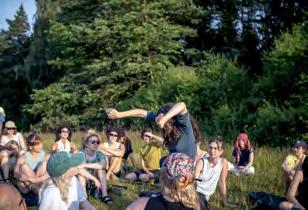

LENGUAS DE AGUA
2024–25
(Water Tongues) The project Lenguas de agua emerged from an invitation from a group of residents of Llanos de Penagos, a village in Cantabria, to develop an artwork that would help revitalize the community’s long-standing relationship with its water sources and its stream, the Ozudera. The residents suggested focusing on the restoration of the village’s three communal natural spring fountains, which Estruch envisioned as mouths capable of giving voice to bodies of water. Inspired by waterspout gargoyles, whistling vessels, rainmaking songs, and aquatic Cantabrian folklore—including the legend of the fish-man of nearby
Liérganes—she conceived a bronze tongue sculpture for each fountain, encouraging the water to speak, sing, gurgle, and babble. Lengua de aire B is one of this project’s new aerial counterparts. Maintaining the same undulating forms, yet with different inscriptions, the sculptures have become instruments to be played by the air.
Lenguas de agua (2024)
Sculpture: Lenguas de agua (2024), bronze, public artwork, 32.9 × 41.1 × 23.7 cm; Lengua Depósito (Deposit Tongue), bronze, public artwork, 31.5 × 14.2 × 21.8 cm; Lengua Molino (Mill Tongue), bronze, public artwork, 14.9 × 35.7 × 9.8 cm
Performance: open public activation
First presentation: Aguas vivas, Llanos de Penagos (sculpture and open public activation, since July 13, 2024)
Produced by: Concomitentes (2022–24), Fundación Daniel y Nina Carasso
With the collaboration of: residents of Llanos de Penagos
Mediation: Alejandro Alonso Díaz, Sören Meschede
Fabrication: Alfa Arte
Lenguas de aire (Air Tongues) (2025)
Sculpture: Lengua de aire B (Air Tongue B), bronze, 32.9 × 41.1 × 23.7 cm
Produced by: Museo Reina Sofía
Fabrication: Alfa Arte
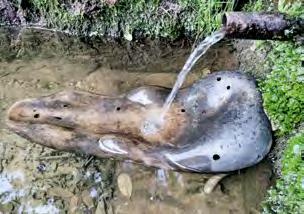
Sculpture: 3 parts, nylon, 2 parts: 100 × 135 cm each, 1 part: 80 × 200 cm
Performance: solo, amplified, approx. 18 min.
Presented at: Segar i cantar, Lo Pati Centre d’Art – Terres de l’Ebre, Amposta / Balada, September 14–November 3, 2024 (sculptures; performance: September 14, 2024)
Produced by: Lo Pati Centre d’Art – Terres de l’Ebre, Fundación Daniel y Nina Carasso
Fabrication: Tecnodimensión
Curated by: Garba



HELLO EVERYONE AUDIO
2025
Hello Everyone Audio is the multichannel soundtrack for Laia Estruch: Hello Everyone. Wallmounted speakers are positioned throughout the galleries. As visitors move through the exhibition and encounter the tangible and visual elements of Estruch’s practice, they pass through walls of sound waves— noise, music, and language that is spoken, whispered, shouted, or sung by the artist. Some of these sounds derive from recordings of her performance rehearsals and activations since 2011, while others stem from preliminary studio sessions, as well as songs and tracks released on vinyl, cassette, CD, or in digital formats. Working with her long-time collaborator, musician and producer Xavi Lloses, Estruch has designed each speaker’s loop and the localized soundscapes they create to relate to the artworks nearby. The auditory experience shifts from a communal hubbub, where the artist’s audio archive mingles with ambient sounds of other voices, to a more intimate sense of listening in on private conversations.
Audio: Hello Everyone Audio, 7 parts, sound installation, duration variable
Presented at: Laia Estruch: Hello Everyone, Museo Reina Sofía, Madrid, February 26–September 1, 2025
Produced by: Museo Reina Sofía
Audio production: Xavi Lloses
Curated by: Latitudes
HELLO EVERYONE VÍDEO
2025
Through Hello Everyone Vídeo, Estruch addresses questions of embodiment and performativity beyond the direct physical presence of the artist herself, while probing the often contested relationship between performance, documentation, and video in the age of networked media. It comprises a multipart montage of
moving images and sounds drawn from various sources and formats, including rough cuts of Estruch’s public performances originally shot with a purely documentary intent, footage of training exercises recorded informally, as well as edited sequences conceived as standalone films but rarely presented as such. Edited by video producer and director Anxo Casal, the sequences are conceived for exhibition display as well as for dissemination through social media and mobile screens.
Employing a rhythmic layering of both synchronized and unsynchronized sound and image, the videos extend two recurring concepts in Estruch’s practice—the announcement or advertisement, and the dynamic document.
Video: Hello Everyone Vídeo, 4 parts, various durations
Presented at: Laia Estruch: Hello Everyone, Museo Reina Sofía, Madrid, February 26–September 1, 2025
Produced by: Museo Reina Sofía
Video production: Anxo Casal
Curated by: Latitudes

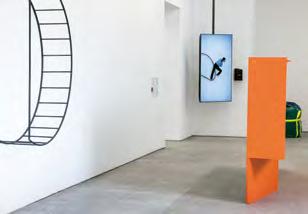




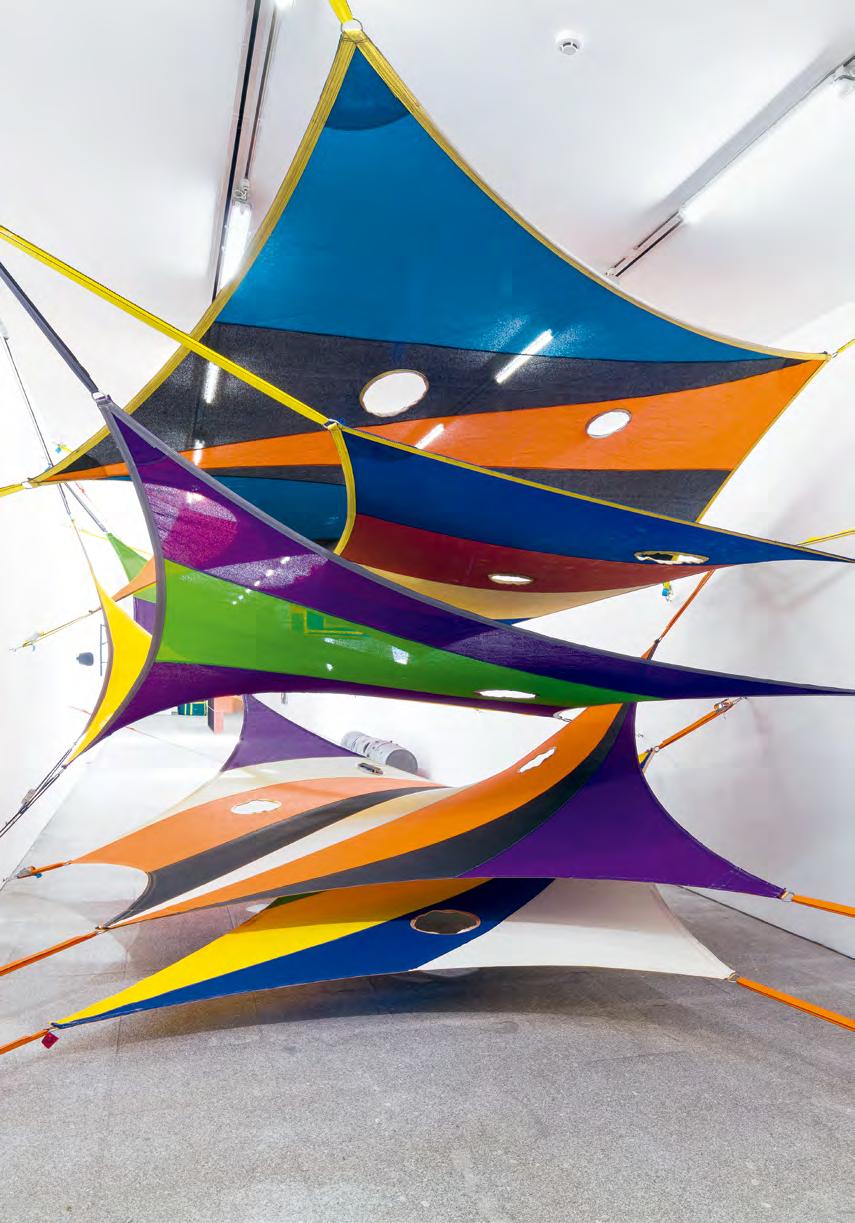





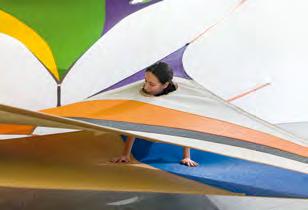
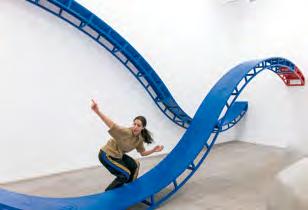

If art today is the result of multiple mirrored reflections, layers and layers of meaning that build up and contaminate one another, then the work of Laia Estruch (b. 1981, Barcelona) appears before us like a latent, perpetually evolving index of that rich amalgamation. An archive of various paths of formal experimentation through which the Catalan artist exhibits her expressed desire to delve into reality and put it to the test.
The exhibition Laia Estruch: Hello Everyone is, beginning with its very title, an invitation to approach the work that Estruch has been creating for over two decades without preconceptions. It is a surprising body of work that, in this show, acquires new and fertile readings in how it bravely interprets the world and the things within it.
Estruch’s creative work contains both the concerns and questions as well as the languages she has drawn on in her well-established artistic career. Performance and sculpture are, as she herself notes, the main frameworks of her artistic practice. Emerging along that path, here and there, is a magical alliance of body, gesture, word, territory, and, most especially, voice—always with an irrepressible determination to see beyond and to delve into mystery, into the far side of what happens to us.
In his book La via della narrazione (The Path of Narration), Alessandro Baricco reflects on the sheer number of decisions made by those who narrate, consciously or not. There are also countless decisions in Laia Estruch’s work, a corpus that echoes with that fundamental question that Baricco poses: “Where does the miracle of a voice come from?” Perhaps this exhibition, so thoroughly saturated by voices and sonorous registers, can provide us with some revelatory answers.
My gratitude to the Latitudes curatorial team, made up of Max Andrews and Mariana Cánepa Luna, and to the Museo Nacional Centro de Arte Reina Sofía, for offering us this bold retrospective reflection on the work of Laia Estruch.
Ernest Urtasun Domènech Minister of Culture
Using the voice and body as the main instruments of her work, Laia Estruch (b. 1981, Barcelona) has developed an artistic practice located at the crossroads of performance and exhibition. Through long-term projects that are decidedly processual in nature, Estruch explores the possibilities that open up when approaching language, sound, and movement through their materiality. These are projects in which improvisation, the use of mediated documentary sources, and a reflection on how we relate to time and space all play a key role. The creation of interactive sculptural devices has taken on increasing importance in her work. Estruch conceives of them as a “body-instrument that inhabits the scene,” and they are often marked with inscriptions, like notations or musical scores for the body, that serve as a guide for her choreographic and vocal improvisations.
The exhibition Laia Estruch: Hello Everyone revisits a broad selection of her works, created from 2011 to the present, unfolding as an archive in which live events, sculptures, sound installations, moving images, graphic works, and visual scores all exist side by side. The show’s title was taken from a conceptual monologue that Estruch used to open her performances of Jingle (2011), a work conceived of as a self-mythologizing viral campaign to make herself known to Barcelona’s art scene. In the words of Max Andrews and Mariana Cánepa Luna, members of the collective Latitudes responsible for curating the exhibit, the work served as a sort of “wry declaration of intent about Estruch finding her ‘authentic voice’ as an artist.”
Jingle registered Estruch’s desire to weave together visual art, oral poetry, music, experimental theater, contemporary dance, and corporeal practice, which would henceforth mark her work. Essential to this trajectory was her time in New York and her classes at Cooper Union, where she came in contact with projects that were foundational to the interdisciplinary genre of the performative exhibition. That experience would be a catalyst for her intuition that “performance could be experienced as subjective, corporeal, and affective,” as Andrews and Cánepa Luna note, but also could be reread through documentation of the work as a discursive artistic object that does not fade away when the performance itself is over.
Her investigation of autobiography and the centrality of emotions in seeking out a new way of acting upon her own memory become clear in works such as Performance al teatre. En lloc d’actuar fabulo (Performance at the Theater: Instead of Acting I Fabulate, 2012), which consists of an almost therapeutic exercise used to address a family drama. Several projects beginning in the mid-2010s foreground the use of documentary sources and a variety of found objects as a point of departure to create what are known in public policy or software development as “living documents”—documents that serve as notations or scores,
subject to various, successive reinterpretations. One such work is /fu:d/ (2014), in which Estruch uses excerpts from Mrs. Beeton’s Book of Household Management (1861)—a Victorian-era manual on cookery and domestic tasks for bourgeois British women—to carry out a series of vocal works in which she confronts issues such as the gendered division of labor and the regulatory effect of written recipes.
Estruch introduced a new element to her artistic work, sculpture, with the series Moat, a set of site-specific projects developed between 2016 and 2017, from which the object emerges—though one very much possessing performative qualities. In Moat, the incorporation of modular structures, first made out of metal and then from polyester fabric and PVC, allowed the artist to generate a staging area to explore body movement and vocal expression elevated above the floor, the traditional platform of dance and theater. In the third installment of this series, Moat-3 (2017), she advanced her exploration of the performative qualities of sculpture through inflatable structures that allowed her to create a soft, malleable body that even seemed to breathe and hum.
This body-voice-sculpture symbiosis is also present in projects in which she explores the expressive and sonorous possibilities of the underwater voice, such as Crol (Crawl, 2019–20), an action she carried out in public pools transformed into sonorous stages where her submerged body, her voice, and her breath interact with large pneumatic sculptures similar to chain links and buoys. Estruch’s investigation of the voice expands in her work on the sounds produced by the air and wind, such as the whistles in Ocells perduts (Stray Birds, 2021–22) and Kite (2022–24), a series of performance installations carried out with multicolor textile panels, much like sails, with which she constructed aerodynamic sets that allowed her to investigate the interaction between natural air currents and the airflows produced by the human voice.
Her work on the concept of the “living document” acquires a new dimension in Ganivet (Knife, 2020/2025), a metallic sculpture in which she inserted a series of inscriptions that serve as a tactile notation. They provide a guide for the voice and movement improvisations in this series of performances about the work of Joan Brossa, an artist who did pioneering work at the intersection of poetry with the visual and dramatic arts.
From her growing interest in taking her work beyond institutional frameworks, in some of her most recent projects, such as Trena (Braid, 2023/2025), Estruch has sought to actively involve the public, working to integrate the interference and interruptions generated by the interaction with urban space as yet another artistic material. This discursive displacement prescribes the social, anthropological, and political dimension that has always been present in her practice. Because behind her determination to center vocal and bodily expression from
a place of intersubjective materiality, and to explore how the sounds and movements of bodies interact with space and can as a result both enforce and subvert its rules, lies a firm commitment to “the politics of speaking up, out, and back,” as Andrews and Cánepa Luna put it. It is a commitment that, in her case, not only embodies a refusal to “be silent” in the public sphere—that command that has historically conditioned women’s voices—but that also expresses a demand to be listened to— and to listen—in a new way.
The relational overview that Laia Estruch: Hello Everyone proposes of the projects Laia Estruch has developed over the last fifteen years allows us to uncover the multiple overlapping layers of her work. By activating an expository device that attends to the specificities of her artistic proposal—by serving both as a retrospective and as a living repository that reconfigures her body of work—the show emphasizes how this artist has managed to organically intertwine the performative with the sculptural, introspective reflection with a quest for political agency, and experimental drive with a poetic impulse. In this symbiosis lies her work’s ability to pierce through us and confront us with, as the artist puts it, “the multiple voices that live within us.”
Manuel Segade Director of the Museo Nacional Centro
de Arte Reina Sofía
